
A SEASON TO celebrate CENTRAL VIRGINIA HOME design ✦ improve ✦ garden ✦ live HOLIDAY/WINTER 2022 SEASON OF SPARKLE glittering décor sentimental displays ELEVATED ENTERTAINING holiday parties cookie pizazz WINTER WONDERS feathered friends barn quilt tour





SERVING THE CENTRAL VIRGINIA AREA FOR ALMOST 25 YEARS, Offering vinyl and aluminum railing systems, fencing, pergolas and more using superior materials that are easily installed and maintenance free. 434-237-2800 • VINYLPORCHRAILS.COM DIY PACKAGES AVAILABLE call us! VINYL RAILINGS & GAZEBOVINYL RAILINGS ALUMINUM RAILINGS GLASS RAILINGS

FOR





Bedford, Rocky Mount, Roanoke, Christiansburg, Radford www.vafurnituremarket.com Celebrate the Season around the Table SCAN
DINING GROUPS





































5 INTRA-MATIC AUTOMATIC CHRONOGRAPH SWISS MADE HAMILTONWATCH.COM










• DOWNSIZING • RELOCATION • UPSIZING NADINE CAN HELP YOU WITH ALL YOUR REAL ESTATE NEEDS! New Home! 20395 Timberlake Rd., Lynchburg, VA • 832-1100 1st Olympic, REALTORS® Licensed in the Commonwealth of VA Celebrate The Holidays In Your (434 ) 444-2226 Call for a FREE MARKET ANALYSIS! www.NadineBlakelyHomes.com email:nadineblakely @remax.net Nadine Blakely REALTOR® ASP,CLHMS,CNHMS,SRES RE/MAX AGENT in VIRGINIA for 2022!* # 1 * RE/MAX rankings for RESIDENTIAL SALES 1/1/2022 thru 9/30/2022 Since 2008,Nadine has been an ACCREDITED STAGING PROFESSIONAL Nadine will STAGE YOUR HOME for FREE * * When you list with her. NEED TOSELL, BUY,OR BOTH? Nadine knows how to STAGE, STRATEGICALLY PRICE YOUR HOME, and CREATE AN EXTENSIVE ADVERTISING and MARKETING PLAN to CREATE MAXIMUM EXPOSURE TO SHOWCASE YOUR HOME ... and GET IT SOLD!



SPECIALIZING IN ESTATE PLANNING www.davies-davies.net | (434) 528-5500 | 4935 Boonsboro Road, Lynchburg, VA 24503 Wills and Trusts Estate Administration Probate Tax Planning Fiduciary Services Including Executor, Administrator, and Trustee




4925 Boonsboro Rd, Lynchburg VA 24503 434 - 384 - CASA Tuesday - Friday 11 AM - 5 PM Saturday 11 AM - 4 PM Boonsboro Shopping Center
With over 40 years of experience, hundreds of satisfied customers throughout central and southwest Virginia, and an Interior Designer on-staff, we can facilitate your project from


to completion.

FSFOURSEASONS.COM | FACEBOOK.COM/FSFOURSEASONS | 2944 ORANGE AVENUE NE, ROANOKE
design









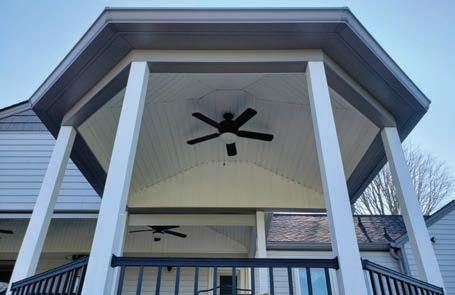



12 REMODELING/RENOVATION • ROOFING • PORCHES AND DECKS GUTTERS • WINDOWS AND DOORS 2016 Lakeside Drive, Lynchburg 434.525.6307 collinscustombuilders.com • collinssidingandwindows.com READERS’ FAVORITE IN 5 CATEGORIES SUNROOMS, SCREENED PORCHES, ADDITIONS, DECKS, SIDING, GUTTERS, ROOFING, REPLACEMENT WINDOWS OVER 30 YEARS EXPERIENCE
CONTENTS
Central Virginia HOME Holiday/Winter 2022

IT UP
beautiful
JANE RENNYSON
wraps
A CIRCLE OF STYLE

the most of curvy trends BY MARGIE LIPPARD
HOLIDAY SPARKLE

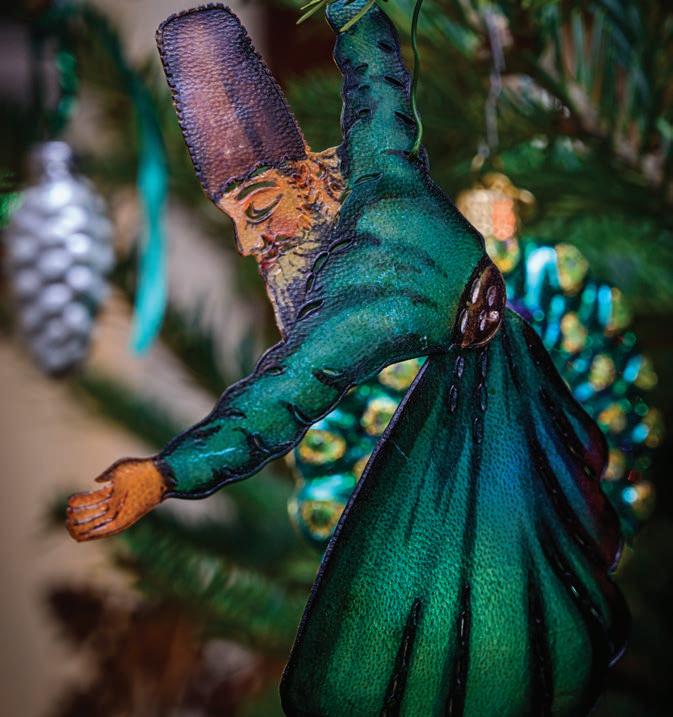
the season with the Hunts
CARTER HEALD BENDALL
TIME
MITZI
you
cvhomemagazine.com 13
94 5070 50
Make
70
Celebrate
BY
94 ME
Find a hobby
love this winter BY
BIBLE 25 FACEBOOK: HOMEmagazineVA INSTAGRAM: @ HOMEmagazineVA Cover photo: Michael Patch 25 WRAP
Create
gift
BY
DESIGN
STYLISH SOFAS
the perfect piece for your space
BY ALYSSA MERCADANTE
BELOVED KEEPSAKES
display your holiday
BY JESSIE THOMPSON
COZY THROWS
and style a bevy of blankets
PAULA PETERS CHAMBERS
IMPROVE
A BREATH OF FRESH AIR
buy an air purifier?
 AMELIA POORE
AMELIA POORE
AVOID COLD SHOWERS

your aging water heater
JERRY HALE
GARDEN
MOTH ORCHIDS

joy in bloom
MARGENE WHITLER HUCEK
WINTER BIRDING
for our feathered friends
BECKY CALVERT
OUR GUEST
now for holiday
SLOANE LUCAS
COOKIE SWAP
a new favorite to
NICHOLAS
BARN QUILTS

old Dutch tradition
KENDALL ATKINS LIVICK
14 C entral Virginia HOME Holiday/Winter 2022 HOLIDAY/WINTER 2022 110 39 32 105
32
Choose
58
Creatively
collections
83
Buy
BY
43
Why
BY
105
Replace
BY
39
Discover
BY
88
Care
BY
LIVE 64 BE
Prep
entertaining BY
101
Find
share BY SARAH
110
An
reimagined BY



PRINT IT AT PICCADILLY... STATIONERY, INVITATIONS & PARTY SWAG!!! DEBRA CUNNINGHAM (540) 520.6837 RSVPPROOFS@GMAIL.COM FIND US IN IVY’S PICCADILLY (540) 566.3359 | @POINTONPICCADILLY ALL THINGS NEEDLEPOINT Located in Ivy’s Fine gifts · Home FURNISHINGS · Bridal registry 3117 franklin road, suite 1a roanoke, virginia 24014 (540) 400.6900 @ivys.piccadilly
I started thinking about Christmas in July this year. I just couldn’t help myself! When the oppressive heat and humidity overtook me, I daydreamed about lighting a fire, drinking a mug of steaming deliciousness and wrapping myself in a cozy throw. While I tried hard to stay in the present and enjoy those scorching summer days, I’ll admit I may have draped my deck in some twinkle lights to assuage my holiday desires. So you can imagine my delight that we’re now stepping into the cozy season, and I can fully live out my joy in all things winter!
Every year, I start planning early to make the most of the holiday season. I buy gifts that remind me of people I love in August. I address cards in October. I start pushing my husband to decorate as soon as Halloween is done. I am ridiculous! Still, I think starting early with some planning and routine tasks allows me to enjoy the season more — and I want to drink in every moment. So as you hold this issue in your hands in early November, I hope you are inspired by some ideas to enjoy your holidays to the fullest, too!
First, you’ll want to peruse our gorgeous showcase home. The Hunts’ home is beautiful year round, but during the holidays it is magical. As Carter Heald Bendall writes: Their house is filled with not only lovely items but also beautiful stories of kindness and friendship. Many say, “all roads lead home at Christmas,” and if you are lucky, your road may lead to this house.

Next, check out some ways to make the most of the coziest season. Buy a new throw and style it perfectly for your home — or just snuggle up on cold nights. Discover new ways to display your cherished holiday collections and wrap gifts. Explore a hobby to lift your spirits when the shorter days begin. Learn about ways to treat the feathered friends who are wintering outside your window. Go for a ride and enjoy a tour of barn quilts not far from home. Try your hand at cultivating a moth orchid, which is easier than you might imagine.
Finally, friends, as you step into this new season, I want to invite you into something new I am doing: Radio! Each Saturday morning, tune into WLNI 105.9 from 9-10 a.m. to hear The HOME Show, where we’ll share inspiring ideas, meet fantastic local folks, and host some giveaways. I welcome your thoughts on the show and magazine! Please share any ideas you have that we can bring to life through James River Media. I look forward to hearing from you!
Happy Holidays and Merry Christmas, Donna Dunn donna@jamesrivermedia.com


16 C entral Virginia HOME Holiday/Winter 2022
EDITOR’S note 434.993.0888 | spectrumstonedesigns.com NEW SHOWROOM NOW OPEN IN FOREST Locally Owned in Lynchburg READERS’ FAVORITES AWARDS 2022


Visit us Online 24/7 at www.GrandHF.com LYNCHBURG 5401 Fort Avenue | (434) 239-5900 | Open Every Day except Wednesday
Who

Trish Roth
EDITOR
Dunn
DIRECTOR

Byrd
CONTRIBUTING WRITERS



Carter Heald Bendall

Mitzi Bible
Becky Calvert Paula Peters Chambers Jerry Hale Margie Lippard
Kendal Atkins Livick Sloane Lucas

Alyssa Mercadante Sarah Nicholas Amelia Poore Jane Rennyson Jessie Thompson Margene Whitler Hucek
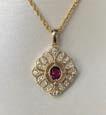
PHOTOGRAPHER

Michael Patch
GRAPHIC DESIGNER
Donna Collins

ADVERTISING SALES

Kirsten Morey Becker Julia Belvin Joe Katany Anne Marie Poore Kenny Shelton
SUBSCRIPTIONS
Central Virginia HOME is published five times annually by James River Media, LLC. For an annual subscription, please send $20 and your name, address and telephone number to: Central Virginia HOME 109B Tradewynd Drive, Lynchburg, VA 24502
For advertising information please call (434) 845-5463 or email HOME@jamesrivermedia.com
To discuss coverage of an event relating to home or garden, please contact Central Virginia HOME at HOME@jamesrivermedia.com

JAMES RIVER MEDIA, LLC (434) 845-5463

Copyright 2022 by James River Media, LLC. All rights reserved. No part of this publication may be reproduced or transmitted in any form or by any means without written permission from James River Media, LLC. All pictorial material reproduced in this magazine, whether in a produced ad or by itself, has been accepted on the condition that it is with the knowledge and prior consent of the photographer or the artist concerned. As such, James River Media, LLC is not responsible for any infringement of copyright or otherwise arising out of publication thereof. The information contained herein has been obtained from sources believed to be reliable. However, James River Media Group, LLC makes no warrant to the accuracy or reliability of this information. Opinions expressed in this magazine are those of the authors and do not necessarily reflect the opinions of ownership or management.

18 C entral Virginia HOME Holiday/Winter 2022 VOLUME 1 6 ISSUE 5 PUBLISHER
Donna
ART
Chris
CENTRAL VIRGINIA HOME Bridge Loans • Renovation • Construction • Land Loans • 100% Financing • Home Equity Lines of Credit • FHA • VA • Rural Development • Conventional • Purchase and Refinance *Subject to credit approval. Certain restrictions apply. Member FDIC Apply online at firstbank.com/get-a-mortgage
you choose to finance yourhome with can make all the difference in your overall experience. We are Our jewelry professionals take your vision to create the perfect custom design jewelry just for you! All our jewelry repair services are done in-house with free estimates. Free jewelry cleaning and inspection is one of our many services. Antwerp, Belgium We are committed to serving our customers as the premier jewelry store in Central Virginia. Visit us to see what we can do for you! 111 N Bridge St, Bedford, VA 24523 www.ArthursJewelry.com (540) 586-8034 As a direct importer of diamonds from Antwerp Belgium, the Diamond Capital of the world, we secure the very finest diamonds from the vast selection available, direct from the cutters for you.



cvhomemagazine.com 1 9 YvonneJansenProperties.com 113 Goldenrod Place, Lynchburg, VA Direct: 434-509-0201 Office: 434-439-4211 MERRY C3hristmas!
e are close to the deadline as I sit with my morning coffee to write this issue’s publisher’s note. It’s always the hardest thing for me to do! As I reflect on this past year and the many changes it has brought to my life, I am encouraged. I have been in this role for about six months and have learned so much. I’ve made some mistakes, learned from them and am proud to work alongside a team of amazing people who work so hard to bring you HOME. It’s been rewarding and full of challenges, and I am excited for 2023!
I’ve had several people ask me what, if any, plans we have in changing HOME. The focus will remain the same, to be your go-to magazine for all things home. In our effort to be a communitybased local resource for our advertisers and readers, one thing we’re excited to introduce this issue is a nonprofit spotlight. See page 56 to learn all about Mustaches 4 Kids Lynchburg and how they support kid-focused charities in our area. We’re also bringing HOME to life on the radio, see Donna’s editor’s note to read all about it!



This issue is full of holiday fun! I have hosted cookie exchanges for many years, which sparked the idea for our cookie article. I baked all of the

cookies to photograph them, and they all have my stamp of approval! Who knew that a cookie with olive oil and rosemary would end up being my favorite? Trust me, bake them!
Thank you for picking this up, taking a look and giving it a read. I hope you find many things that inspire you as we head into the holidays. Take a breath, slow your pace a bit, enjoy your family and friends and soak up the season.
Trish Roth, Publisher

20 C entral Virginia HOME Holiday/Winter 2022 PUBLISHER’S note Visit our 10,000+ sq. ft. showroom to see our selection. Our trained staff is ready to help you create your perfect outdoor living space. 3112 MELROSE AVE., ROANOKE 540.345.7665 • NATIONALPOOLS.COM the area’s largest selection of OUTDOOR FURNITURE SEATING GROUPS • DINING SETS • BARSTOOLS • FIRE PITS • UMBRELLAS • CHAISE LOUNGES W
Happy holidays to you and yours!


FIND HAPPINESS: ADOPT FROM THE LYNCHBURG HUMANE SOCIETY! Daniele Merry and Bright LICENSED REALTOR 434.444.3888 KATE BLICKENSTAFF POATS 434.258.1400 @liveinlynchburg katepoats.com JANE BLICKENSTAFF 434.660.3773 @blickenstaffandcompany janeblickenstaff.net WISHING YOU A HAPPY AND HEALTHY HOLIDAY SEASON!
First Sight
LOVE AT
First Sight
There is always a great story when you talk to each of our residents. fulfilling life and living all over the country. Early on, these two knew the right location, and Westminster Canterbury of Lynchburg was the choice for them.

Life for them has never been busier: golf and more golf, pickle ball, weekly trips, swimming and enjoying dinner with friends at one of three dining venues.
There is always a great story when you talk to each of our residents. Theirs is a story of love, a fulfilling life and living all over the country. Early on, these two knew that Lynchburg, Virginia was the right location, and Westminster Canterbury of Lynchburg was the best retirement community choice for them.
Let Westminster Canterbury be your best decision by giving us a call today. Our beautiful, 52-acre campus and nationally recognized LifeCare program is ready to give you a place to tell your story and help you Discover Life Refreshed!
Life for them has never been busier: golf and more golf, pickle ball, weekly trips, swimming and enjoying dinner with friends at one of three dining venues.
Let Westminster Canterbury be your best decision by giving us a call today. Our beautiful, 52-acre campus and nationally recognized LifeCare program is ready to give you a place to tell your story and help you Discover Life Refreshed!
Start the Conversation by Calling Laura at (434) 386-3305
501 V.E.S. Road, Lynchburg
WCLynchburg.org
Start the Conversation by Calling Laura at (434) 386-3305

22 C entral Virginia HOME Holiday/Winter 2022
WC HM-2203 9
We met at age 15, and are enjoying 60 years of marriage... And we Love where we chose to retire!
“
”
We met at age 15, and are enjoying 60 years of marriage... And we Love where we chose to retire!
“
”




cvhomemagazine.com 2 3 DOORTEK GARAGE DOOR SERVICE is a family owned and operated business that is dedicated to providing the highest quality products and best service for both residential and commercial customers in Lynchburg and surrounding areas. DoorTek’s mission is to raise the standards in the garage door industry, and create an amazing experience when installing, repairing, or maintaining your garage door. INSTALLATION, REPAIRS, MAINTENANCE 434-237-1011 • DOORTEKVA.COM COME HOME TO STYLE WCLynchburg.org 501 V.E.S. Road, Lynchburg WC HM-2203 9 residents. Theirs is a story of love, a knew that Lynchburg, Virginia was the best retirement community
WHAT

YOUR ADVISOR TELLING YOU?


C entral Virginia HOME Holiday/Winter 2022 Allan Malina, President 434-316-0246 • www.servuscm.com 1922 Graves Mill Road, Lynchburg RETURNS FOR ILLUSTRATIVE PURPOSE. THIS IS NOT A SUGGESTION TO BUY, SELL OR USE A PLATFORM. ONLY WILL A SUGGESTION OCCUR AFTER A MEETING TO DETERMINE GOALS, RISK TOLERANCE AND TIME HORIZONS. INVESTMENTS INVOLVE RISKS AND NO GUARANTEE OF FUTURE RESULTS. PURPOSE DRIVEN FINANCIAL ADVISING & INVESTMENT MANAGEMENT
IS
Hopefully it’s not, “Don’t worry, wait it out, it will come back!” Contact me to discuss your portfolio. Tune into my radio show, PURPOSE DRIVEN FINANCES Saturday mornings on WLNI.
More Than

A Bow On Top Clever and Creative Gift Wrap
BY JANE RENNYSON
The best gifts are often the ones you’d like to keep for yourself. Help your gift receiver to enjoy the moment as much as the gift. From unique paper to embellishments, your personalized gift presentation will help the recipients to slow down, not rush past the moment and savor the sight of what has been laid before them.
Let’s explore the wide range of creative ideas available when wrapping a gift.

cvhomemagazine.com 2 5
Unconventional choices for wrapping paper
When we think of preparing a gift, we instantly think of wrapping paper. But we aren’t limited to the typical holiday or birthday paper with snowmen or candles on it anymore. Consider using a more personalized selection based on who will be on the receiving end of your gift.


Fans of all things classic will delight in a gift presented in vintage newspapers. Try to find one close to their birth year, or a special period in their lives. Similarly, a gift wrapped in old, handwritten letters will add a historical feel to the presentation. Maps, sheet music, leftover wallpaper, or a printed word search are unique and whimsical ways to wrap a gift.
Layering is another way to elevate the look of your gift. Start with a simple paper, such as plain white or brown craft paper and add any one of the options above. Or choose two patterned papers with contrasting designs but similar colors, and wrap each half of the present. Complete the look with a coordinating colored ribbon separating the two sides. Plain black paper with white paint pen lettering or drawings mimics a chalkboard, and is an ideal presentation for teacher gifts.
Other substitutions for traditional wrapping paper include a handkerchief, a scarf, or burlap fabric. Baby gifts can be bundled up in a cozy blanket and tied with a beautiful satin ribbon. Use a tea towel or two to wrap a kitchenthemed gift for a wedding shower or housewarming party, and your favorite fabrics can easily be made into no-sew gift bags. Simply cut two pieces of fabric into the same size using pinking scissors. This will create a fun zig-zag edge that won’t fray. Attach double-sided tape to the inside of one of the swatches of fabric on all three sides. Firmly press the other piece of fabric on top, insert your gift and tie up the top. Voila — a gorgeous way to present your gift!
Distinctive decorations

Now that you have created the base of your wrapping, it’s time to think outside the gift box. Embellishments will take your gifts from wonderful to wow!
You may have seen candy canes, ornaments, pine cones and greenery adorning presents for the holidays, but

26 C entral Virginia HOME Holiday/Winter 2022
CLEAN AIR + HOME COMFORT HAPPY FAMILY www.terrellemoseley.com • 434-847-1223 YOUR TRUSTED HEATING, COOLING & AIR QUALITY SPECIALIST FOR 86 YEARS 100% No-risk GUARANTEE on everything we do! We have solutions to make your home’s air healthier and your HVAC system more energy efficient.
have you ever considered wrapping your holiday presents in battery-powered lights? Or creating a winter or holiday scene on the top of your present with small trinkets and figurines? To accomplish this look, spray your wrapped present with a light layer of faux snow and allow it to dry for three to four hours. Then create the scene by attaching Christmas trees, carolers, snowmen, street lamps, Santa and his reindeer, or even characters from your favorite holiday movies. For Hanukkah, use gold or silver spray paint and add a menorah, a dreidel, or the Star of David. This idea is not limited to winter holidays. Toy cars, action figures, animals, doll house furniture, and tiny fairies can create a delightful scene for children’s gifts.
Other attractive items to adorn your presents include feathers, buttons, pompoms, tassels, beads, pearls or jewels. Use alphabet letters to write a message on the outside of your gift such as “No peeking,” “Surprises inside” or “Prepared with love.”
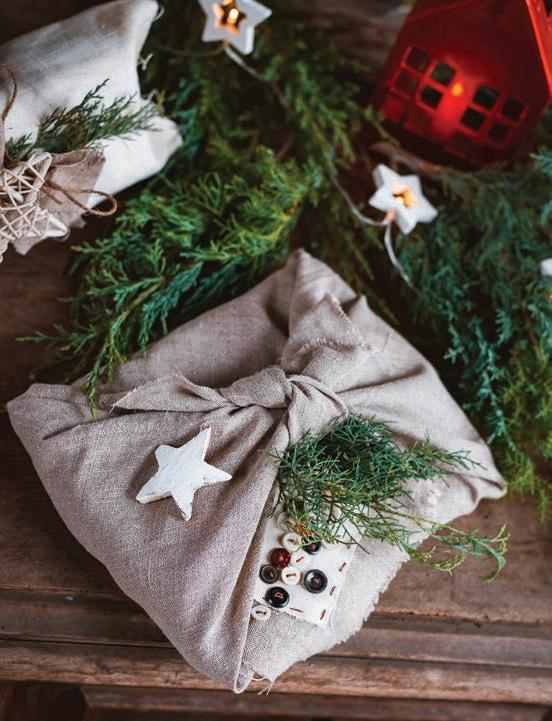





Stamps and stencils offer another way to jazz up simple wrapping paper. If you used old maps, letters and newspapers as wrapping paper, add twine and a wax seal to complete the vintage look. For a fancy and feminine presentation, add lace or doilies on top of solid colored paper. Flowers and greenery are another way to add interest. A tiny bouquet of dried flowers wrapped in burlap would look adorable on any present. Or draw a vase on a plainly wrapped present, and glue on flowers so they look like they are in the vase. Another idea is to use pressed flowers. Position dried, pressed flowers on top of the gift and use clear contact paper to secure them in place.

cvhomemagazine.com WWW.SWEETPEASONMAIN.COM Monday - Friday 7am to 3pm Saturday 8am to 3pm 320 S Main Street, Gretna | P: 434.200.8833 WWW.THEPODGRETNA.COM APPAREL | GIFTS | HOME DECOR Monday - Friday 9am to 5pm Saturday 9am to 3pm 320 S Main Street, Gretna | P: 434.770.3030 BREAKFAST | LUNCH | BRUNCH eas weet WWW.SWEETPEAS.COM
LIGHTING AND DECOR
All tied up
Ribbons and trim will add a finishing touch to your pile of presents. Instead of using a single ribbon, use three different ribbons in small, medium and wide widths. First tape the wide ribbon around the box, then add the medium and smaller widths on top of each other for a layered look. You can also create a basket weave pattern around your present with two different sizes of ribbon. Wrap individual pieces of ribbon around the box and tape together on the bottom. Next, tape a smaller sized ribbon perpendicular to that ribbon and wrap it around the box, alternating over and under the existing ribbon.






Tulle in any color is an elegant substitute for


and yarn wrapped around the present in a rainbow pattern is sure to make anyone smile. There are numerous tutorials available to learn how to make your own bows. But don’t just add one bow. Make three or four bows in different sizes and attach them in order, smallest to largest.


C entral Virginia HOME Holiday/Winter 2022
traditional ribbon,
WISHING YOU THE HOLIDAY SEASON THAT YOUR HEART DESIRES CASUAL AND RELAXed OR FESTIVE AND FASHIONABLE. WE HAVE THE PERFECT LOOK FOR WHATEVER THE HOlIDAYS BRING! German Smokers H Artificial Designer Trees Ornaments H Celestial Lights Window Candles Egyptian Glass H Fresh Cut Trees Fresh Wreaths H Poinsettias gifts for all ages visit us on facebook for specials & events 4614 BOONSBORO ROAD (434) 384-2441
Take it to the next level by also incorporating some of your gift on the outside of the box with the bow. Secure a sweet treat on your present, or tie on a bracelet, bookmark or bow tie.



Choosing a distinctive way to wrap your presents can be rewarding for this holiday season and beyond. It automatically makes wrapping seem more like an entertaining activity instead of a chore. Gift givers and recipients alike will be amazed by the creativity on display and may even spark a little competition among friends to see who can design and put together the most perfectly wrapped present! ✦

cvhomemagazine.com 29
LYNCHBURG | SMITH MTN. LAKE | FOREST
Imaginehaving an outdoor living area that you and your family can enjoy for years to come. What does that space look like? Is it a space that is framing a picturesque view of the mountains? Is it a poolside escape? Or a beautiful outdoor patio space for entertaining? Whatever you imagine, Land Tech Group will make it come to life!

Land Tech Group offers design-build services for those clients that want to get on our installation schedule or exclusive design services, for a fee, for those who want to put together a design but are not ready to install yet. All of our designs are customized to the client’s wants and needs to create their dream space. Our design services include 2D plans and 3D models to help our clients visualize the potential of their outdoor space.

30 C entral Virginia HOME Holiday/Winter 2022
Tech Group is a class A contractor, and we pride ourselves in building the finest outdoor environments in Central Virginia. Our custom design and installation services include new and renovated landscapes, outdoor living areas (patios, outdoor kitchens, etc.), swimming pools, water features, retaining walls and more. Our knowledgeable staff have more than 60 years combined experience designing and installing outdoor living areas, and we have a certified horticulturist on staff. Land Tech is the only in-ground concrete pool contractor in Central VA that can install both your pool and surrounding outdoor living area in house, without hiring a long list of sub-contractors. We do all of our own concrete pool construction (gunite), pool plumbing equipment/automation systems, masonry (pavers, block, stone work), grading, drainage, landscaping and landscape lighting in house. From simple to complex designs, our construction and design teams work together to bring your project to life. Give us





cvhomemagazine.com 3 1 18971 Forest Road Lynchburg, VA 24502 434.386.5666 Landtechgroup.com Land
HOME premier profile 2022
DESIGN find the right fit
SOFA SHOPPING:
ONE SIZE DOES NOT FIT ALL Things to Consider When Choosing a Sofa
BY ALYSSA MERCADANTE
Sofas are much more than a place to sit. It’s where we find comfort after a long, hard day. It’s where we connect and have meaningful, lifechanging conversations.

For some, it can even be where meals are eaten or work is done. Your sofa can make or break the comfort level of your home, affect the ability to create a conversation space and set the vibe of your lifestyle.
Purchasing a sofa is an investment in more ways than one, so there are some important items to consider when choosing the perfect one for your space.
32 C entral Virginia HOME Holiday/Winter 2022
What atmosphere are you trying to achieve?
Do you want something calming and neutral or bolder and more colorful? What style is the rest of the furniture and décor? Is there a particular painting from your grandmother that you want to pull a color from and tie into your sofa? If you base your purchase strictly on comfort, you could wind up with something that looks quite out of place.
Furniture experts assert that a sofa is a representation of your style and who you are. In that regard, choosing a sofa isn’t very different than picking out your clothes.

Once you know the general style of sofa you are looking for, it’s time to think about how you will use it as well as who will use it. Do you love entertaining and want to create a space for people to sit and have drinks while conversing with each other? If so, a more structured sofa with chairs combo would be suitable. Or do you want something for lounging and cozying up with your significant other or children while watching movies? A plush sectional with abundant seating and reclining options could be your best bet.
What size sofa do you need?
Furniture is not typically one-size-fits-all. A 6'5" man and a petite 5' woman most likely aren’t going to find comfort in the same size sofa. That’s where trying out a sofa in person is vital. You might browse

cvhomemagazine.com 33
sofa styles and colors online, but when it comes down to buying, you’ll want to take a seat.
Buying a sofa can be a very personal experience. That is why furniture stores often ask you a series of questions pertaining to your lifestyle: are pets or kids in the picture? Do you or your spouse prefer to lie down most of the time? Are you a red wine lover?
You are not just an average consumer — you are one of a kind! Only you will know what sofa is the best fit.
Stacy Meeks – Head of Operations at locally-owned Bailey Grey Interiors in Lynchburg – agrees.


“Who knew there are 24 different styles of sofas and couches,” Meeks says. “Our design and sales teams hand pick every unit from fabric and leather selections, leg styles and cushion styles all the way to length and depth. If you don’t see what you want, we customize it for you.”
Another important, and probably obvious, aspect to consider is sizing for your space. What other furniture do you have in the room that you need to work around? If your living room is on the smaller side and not very open, you may want to stick to the more traditional sofa and loveseat or chairs combo that can be easily moved around. If you have a larger space with a more open floor plan, a sectional could be your best option.
Meeks says the biggest pro of owning a sectional is maximized seating.
“Sectionals allow a room, which normally wouldn’t allow a sofa and a loveseat, to have the exact same amount of seating. Lounging comfort is a huge plus. Accommodating overnight guests can also be factored in if one doesn’t have a guest bedroom,” Meeks says.
Sectionals can also be great for breaking up a large, multipurposed space. For example, if you work from home out of your living room, a sectional can help create a partition between your home office area and living area.
Be sure to measure your space and take inventory of other furniture before heading out to sofa shop. Knowing your maximum length is key. And don’t forget to measure doorways, too. If the


34 C entral Virginia HOME Holiday/Winter 2022 PROFESSIONAL carpet cleaning Steam Extraction Pet Odors ScotchGuard Treatment Smoke & Water Removal Bonded & Insured Residential & Commercial On-Site or Pick-up & Delivery 337 St Augustine St., Lynchburg kiddsservices.com WE OFFER RESIDENTIAL CLEANING FOR CARPETS, RUGS, UPHOLSTERY AND MORE. CALL US TODAY FOR A FREE QUOTE. (434) 233-4903
sofa won’t fit through your living room entryway, you may have an issue and need to pivot!
What color, fabric and style matches your home?
There is a cavern of options available these days as far as materials and colors go. Again, it’s important to consider your lifestyle, and even your future lifestyle, when investing. The best pet-friendly material is microfiber as it is easy to clean and difficult to scratch or rip. Microfiber or leather are great options in terms of cleanability and durability if you have children around and are worried about spills and stains.
“Choosing the right sofa material for your lifestyle is imperative,” Meeks says. “We recommend performer-style fabrics and family-proof fabrics. These are expertly-crafted with lasting strength, saturated color and cleanability built in. We sell what we buy for our own families.”
Choosing a sofa isn’t just about the sofa itself – it is far more than that. Think big picture. Mull over your five-year or 10-year plan. It may sound silly, but it really does help. Happy sofa shopping!

ReidsFurnishings.com

now at
cvhomemagazine.com 35
5 THINGS TO CONSIDER WHEN BUYING A SOFA


1. Measure first — your space and doorways to get there.



2. Choose a fabric to fit your lifestyle — look for pet and kid-friendly options if needed.


3. Consider the frame — you can restuff and reupholster down the line, but if the frame is made of poor quality materials, the sofa won’t last.
4. Look at the features — if you want a reclining sofa, be sure to include the width while reclining in your measurements.

5. Decide if you want to be on trend or traditional — rounded edges are back in. See our story on curves on page 50. ✦

36 C entral Virginia HOME Holiday/Winter 2022 1 2 3 4 5
Blackwater
Blackwater Creek


cvhomemagazine.com 37 A beautiful new community in historic Rivermont, right off of the
Trail. Lots starting at $75,000 | www.BlackwaterRun.com A beautiful new community in historic Rivermont, right off of the
Creek Trail. Lots starting at $75,000 | www.BlackwaterRun.com






38 C entral Virginia HOME Holiday/Winter 2022 Preorder for holidays NOW! IN WYNDURST pastries | cakes | pies | bread homemade soup | salad | sandwiches | quiche Sweet and Sav Baked Fesh Dail
Moth Orchids
THE PERFECT CURE FOR WINTER
BY MARGENE WHITLER HUCEK
Orchids, once only available to the wealthy few who could afford greenhouses, have been democratized by the introduction of moth orchids that can be grown successfully in our homes. This graceful orchid, with its thick broad green leaves and arching flower sprays, is now widely available at a reasonable cost.
Large flowers, ranging from pure white, pinks, purples, salmon and lemon yellow, bloom along the orchid’s stalk, opening one at a time. Your orchid will bloom for two to three months if properly cared for.

Moth orchids bloom at approximately the same time each year, so it’s a good idea to purchase plants in the winter if you want winter blooms the following year. Look for an orchid with healthy green leaves; avoid yellow or shriveled leaves. For the longest flower show, pick an orchid with only one or two open blossoms.

An east-facing window is an ideal location for orchids, or try a shaded southern or western window. Keep in mind that the orchid is a tropical plant that appreciates a moist environment. An easy way to increase humidity is to place pots on trays filled with gravel and water.

cvhomemagazine.com 39 GARDEN beautiful blooms
Caring for your orchid Water only when the plant is nearly dry. The easiest way to judge when an orchid needs water is how it feels. A light pot means the plant needs water; if the pot feels heavy, wait a few days. Until you get used to judging your orchid by weight, reach in to feel the medium. Wait to water until it feels fairly dry.
When you water, simulate the tropics by saturating the bark, then draining away any excess water. If the pot is not too heavy and the outside temperature is reasonable, take the plant outside and pour lukewarm water (do not use saltsoftened water) over the medium and let any excess water drain out. In the winter, you can water over the sink or a bucket. Always water in the morning so the foliage will dry before nightfall.
Misting is not a good idea as the moisture from misting is not the same as moisture circulating in the ambient air.



The fairly common practice of using ice cubes to water orchids, while easy, is not a good practice. Ice water, in general, is bad for plant roots and especially so for plants from the tropics. Another consideration is the fact that a couple of ice cubes will not saturate the growing medium.

Moth orchids appreciate being fertilized on a regular schedule. It’s best to use a balanced orchid fertilizer. Every three weeks run clear water through the bark to remove any excess fertilizer.

40 C entral Virginia HOME Holiday/Winter 2022 COMING SOON TO Boonsboro Meadows LILLYCONSTRUCTION.COM 434.534.5764 4 BEDROOMS 2.5 BATHS 2100 SQUARE FEET 434.237.9323 | PlumbCarePlumbing@gmail.com | We Plumb Care Our Team at Plumb Care Plumbing wishes you the Best this Holiday Season and remember... “We Plumb Care”
PRO TIP FROM MARGENE I LIKE TO INTERSPERSE MOISTURE-LOVING FERNS WITH MY ORCHIDS. MOTH ORCHIDS ARE EPIPHYTES — PLANTS THAT GROW ON OTHER PLANTS (SUCH AS TREES) WITH THEIR ROOTS EXPOSED TO ATMOSPHERIC MOISTURE. THEY ARE GROWN IN A SOILLESS MEDIUM, USUALLY FIR BARK. IT IS NORMAL FOR ORCHIDS TO GROW ROOTS ABOVE THE SOIL. THESE GRAY AERIAL ROOTS SHOULD NOT BE TRIMMED. HOWEVER, DO CUT ANY ROOTS THAT ARE BROWN AS THAT INDICATES THEY ARE DEAD.





cvhomemagazine.com 41 something for everygardener WE ARE READY TO HELP WITH YOUR PLANTING NEEDS YEAR ROUND. 2452 Bethel Church Rd, Forest • Open Year Round* • 434.525.3107 • rainfrostnursery.com serving Lynchburg and surrounding counties for over 30 years *HOURS CHANGE WITH THE SEASONS
New blooms
When the last bloom has faded on your orchid plant, you can encourage more blooms by not removing the flower stem.
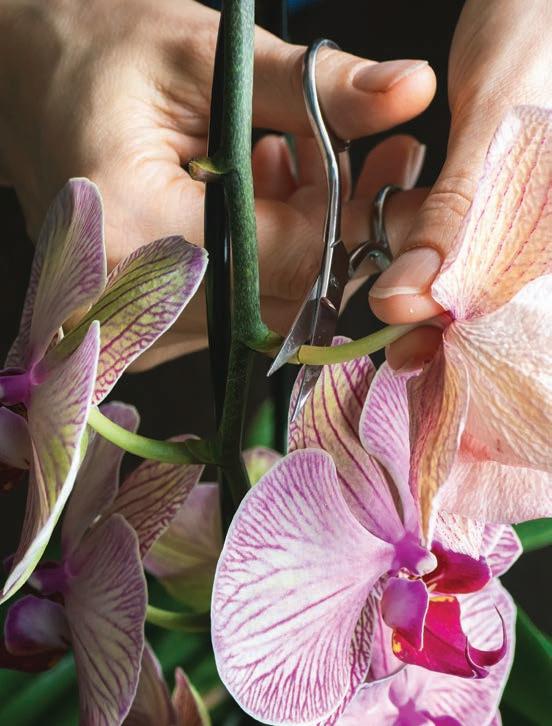
Instead, cut the stem, leaving at least two nodes (the little brown lines on the stem below where the flowers were).
If the orchid is healthy, a second flower spike should grow from a node. You can also cut the spent stem entirely at the base where it comes out of the leaves. The plant should send out a new flower spike in two to three months.

Time to repot
If your orchid starts to grow over the edge of the pot, it is time to either move the orchid to a larger pot or divide it. Even if your plant has not outgrown its container, keep an eye on the health of the planting medium. Once it has started to break down, it is essential to replace it to avoid root rot. The best time to repot is in the spring when root growth is active.
To repot, remove the old potting mix, trim any soft or rotted roots, and spread the remaining roots over new medium. Work the medium among the roots until the junction of the roots and stem is at the top of the medium. Do not trim the gray aerial roots. Resume regular watering, but do not fertilize until you see new growth.

Exotic beauty
Emerson wrote, “If eyes were made for seeing, then Beauty is its own excuse for being.” And the graceful moth orchid, indeed, can claim its reason for being, especially when snow covers the meadows and cold winds blow. ✦
FINEST DOORS



42 C entral Virginia HOME Holiday/Winter 2022
Kathy Acorn, Polly Flint, Moose Pierce, Billy Flint, Nat Perrow, Amy Scott, Victoria Bartholomew, Chantal O’Keeffe
Flint Property Group proudly
represents these three outstanding
developments: Cottage Hill,
The
Preserve at
Oakwood
and Blackwater Run.
434.386.3000 flintpropertygroup.com LYNCHBURG’S BEST AGENTS OPENING LYNCHBURG’S
easier
Clearing The Air Filtering Through Air Purifier Options
 BY AMELIA POORE
BY AMELIA POORE
cooler weather requires all of us to make changes at home to stay comfortable, such as keeping windows and doors tightly closed until mild weather returns. Although closing up our homes keeps us warm, it causes the interior air quality to drop during the winter months due to allergens and pollutants from pets, fireplaces, dryers and stoves. These airborne irritants can cause stale-smelling air and increase respiratory inflammation.
cvhomemagazine.com 43 IMPROVE breathe
How it works
Fortunately, we can combat stale air without sacrificing comfort with air purifiers. Air purifiers remove dust, smoke and pollen from the air. They typically consist of a fan that draws in and circulates air, and a filter. As the fan pulls air through the filter, airborne particles are caught inside, and clean air is recirculated into your home. While an air purifier is not a cure-all, if you are an allergy or asthma sufferer, an air purifier may be helpful for you.
Typically, filters are made of paper, fiber, fiberglass or mesh. The best choice is a HEPA filter (high-efficiency particulate air), which removes 99.97% of air pollutants down to 0.3 microns, such as particulate matter in smoke and paint fumes. Of course, HEPA filters take care of larger particles, too, including dust, pollen and mold spores. HEPA filters use a multi-layered netting made of ultra-fine fiberglass threads, creating a dense sheet of fibers pleated and sealed in a metal or plastic frame. Depending on use, these filters need to be replaced every eight to 12 months.



In addition to HEPA filters, some air purifiers include activated carbon filters to capture odor-causing molecules. Depending on use, activated carbon filters require replacement more frequently than HEPA filters — every three to six months. However, finding an air purifier with a third washable and reusable filter that collects very large particles before they reach the HEPA and carbon filters may extend the filter life and save money on replacements. Keeping the filters clean is the key to an efficient and effective air purifier.

Purifier choices
Aesthetics. HEPA-equipped air purifiers come in a wide range of shapes, colors, and prices. Typically, smaller air purifiers are more aesthetically designed, but most models are non-descript and offered in neutral colors such as white, black or steel gray to fit with any décor.

Effectiveness. To achieve top-effectiveness, place your air purifier in an area with a lot of airflow, such as a hallway or near a door or window. A high-traffic area means moving air, which is more likely to lift dust, mold, and other particles so that the air purifier can suck them in and recirculate clean air. Alternatively, you can place the air purifier in the space you will get the most use out of it, such as the living room or bedroom.
Noise. Another consideration is how loud the air purifier can be without affecting your use of the space. Before purchasing an air purifier, look for its decibel levels on the packaging or website listing. For reference, 50 decibels is roughly equal to the hum of a refrigerator. However, a slightly louder air purifier may be ideal if you use a sound machine or fan for white noise. Moreover, to keep noise to a minimum, try running the air purifier on its highest
44 C entral Virginia HOME Holiday/Winter 2022 Clean. Reliable. Propane. 1505 Rutherford Street • Lynchburg, VA 434-846-6509 • www.wattspetroleum.com READERS’ FAVORITES AWARDS 2022 SERVING (but not limited to): SOUTHWEST VA AND CENTRAL VA Lynchburg Roanoke Danville Charlottesville Smith Mountain Lake Richmond Petersburg Fredericksburg Full Service Local & Long Distance Moves | Licensed Bonded & Insured Estates/Clutter/Trash Removal Services/Local /Veteran Owned 434-525-3444 READERS’ FAVORITES AWARDS 2022
setting when you’re not in the room and lowering it when you’re nearby.

Size. The best air purifier for you depends entirely on your space — the more square-footage you have, the larger the air purifier should be. Some models are small enough to put on a table top, while others must be on the floor. Purifiers come with a CADR (Clean Air Delivery Rate) that can help you calculate the appropriate size. Use this formula to help you choose the right size: CADR x 1.55 = Square footage of your room.
Price. When looking at the price of an air purifier, be sure to factor in the cost of the filters and how regularly they need to be changed. Some larger purifiers need three or four filters to be changed regularly. Spending $75 every 6 months on filters can quickly add up!



Cooler weather can cause us to feel cooped up as we wait for springtime, but circulating clean air throughout the house can be refreshing. A quality purifier improves the air quality without sacrificing warmth and comfort during the winter.



cvhomemagazine.com 45 William Carvajal, MD FACS Board certified facial surgeon with over 19 years of experience in facial cosmetic surgery. 101 ARCHWAY CT SUITE A, LYNCHBURG 434.616.4986 LynchburgAesthetics.net LYNCHBURG’S HOME FOR EXCLUSIVE AESTHETIC SERVICES THE GIFT of BEAUTIFUL SKIN for yourself or a loved one AESTHETIC SERVICES: Facial Cosmetic Surgery • Injectables • Laser Skin Resurfacing Microneedling • BBL Photofacials • IV Vitamin Therapy • Bioidentical Hormones • Facial Services Body Sculpting • Medical Grade Skincare
3 WAYS TO INCREASE AIR QUALITY WITHOUT A PURIFIER WITH OR WITHOUT THE HELP OF AN AIR PURIFIER, THERE ARE OTHER WAYS TO INCREASE THE AIR QUALITY IN YOUR HOME DURING THE WINTER MONTHS.
1. Vacuum regularly Air purifiers remove only airborne particles, not larger allergens that settle on furniture and carpets, such as pet hair or dust mites. Using a vacuum with hepa filtration once or twice a week will keep these larger irritants to a minimum.

2. Limit smoke-causing activities such as smoking, burning candles and woodburning fires.
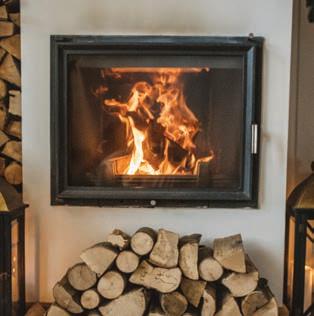


3. Ventilate where you can. Be sure your HVAC filters are clean. If you don’t have central air, consider running the air conditioner on warmer days to move fresh air into your home. When it’s too cold, try running the exhaust fan in the kitchen, bathroom and laundry rooms when in use, and even periodically when not in use, to move stale air out of the house. ✦

46
C
entral Virginia HOME Holiday/Winter 2022 Lynchburg Dental Center offers services in the areas of family dentistry, cosmetic dentistry, teeth whitening, implants and restoration, dentures, and dental hygiene—ensuring confident, healthy smiles. Trust Matters 434-384-7611 Call to Schedule an Appointment LynchburgDentist.com Monday Thursday 8am 5pm OFFICE HOURS Friday 8am 4pm
Brad Lentz, DMD
Carrington Crawford, DDS, FAGD
Karen Kenny, DDS
1 2 3





cvhomemagazine.com 47 FP 17 1-844-529-4957 FortressFoundationSolutions.com WE CAN HELP! Wet Basement? Nasty Crawlspace? Bowing Walls? Sinking concrete?BEFORE BEFOREAFTER





48 C entral Virginia HOME Holiday/Winter 2022 Shop With Us! Boonsboro Shopping Center • PersianRugsandMore.com 434.384.3123 • 800.485.9960 • persianruglady@yahoo.com • Persian Rugs & More Expert Repairs Done In-House Sales • Appraisals • Moth Proofing • Cleaning Get your rugs cleaned in time for the holidays! Boonsboro Shopping Center Boonsboro Shopping Center isabellasitalian.com Yoga Connects the Mind, Body & Soul The Premier Yoga, Hot Yoga & Fitness Studio in Lynchburg 434-722-3581 | www.pranayogaandfitness.com JOIN A CLASS TODAY! $49 UNLIMITED INTRODUCTORY MONTH SPECIAL. Unlimited Yoga/Fitness for the First Month. Yoga gift card ...a gift that lasts a lifetime...











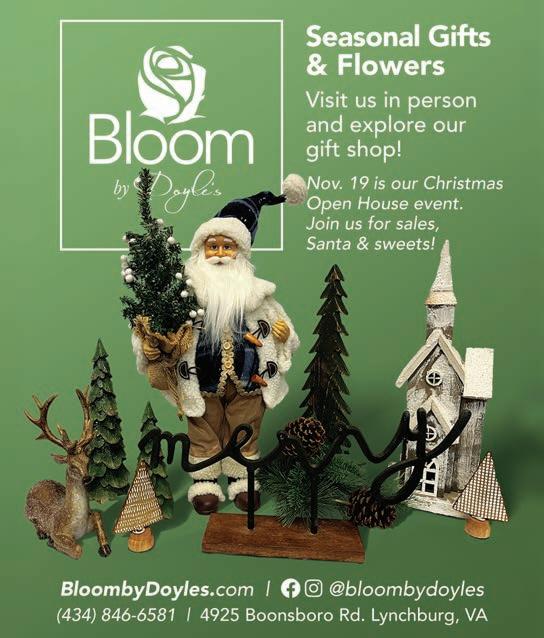

cvhomemagazine.com 49 A unique selection of shopping and dining, coupled with friendly business owners makes Boonsboro Shopping Center a superior shopping destination. 4925 Boonsboro Rd. | Lynchburg, VA 24503 A unique selection of shopping and dining, coupled with friendly business owners makes Boonsboro Shopping Center a superior shopping destination. 4925 Boonsboro Rd. | Lynchburg, VA 24503 paisleygiftslynchburg.com 4925 Boonsboro Road Lynchburg, VA 24503 434.385.0598 DESIGNLYNCHBURG@GMAIL.COM • (4 3 4) 3 84- 3232 sophisticated, yet fun.
COMFORTING CURVES WITH TIMELESS APPEAL
INCORPORATE THIS INVITING TREND THROUGHOUT YOUR HOME
BY MARGIE LIPPARD
The lines of design are softening as the iconic circle and curve motifs surge in popularity among interior designers and consumers. From arched ceilings and curved walls to circular chairs and round mirrors, curved edges are trending. The COVID pandemic has helped fuel today’s escalating demand for rounded shapes, rhythmic curves, and bendy lines in home design. Though lockdowns and quarantines are waning, we still spend more time at home and seek refuge amongst our furnishings and décor. Curvilinear shapes offer a comforting and captivating aesthetic, which enjoys timeless appeal.

50 C entral Virginia HOME Holiday/Winter 2022
What’s behind curve appeal?
Scientific research suggests that curves make us happy. In a 2013 study conducted at the University of Toronto, participants judged spaces with curvilinear features as more beautiful than those with rectilinear elements. Psychology Professor Oshin Vartanian explains, “We have found that people find spaces that have curved features more beautiful than spaces with sharp features, and that this preference is driven primarily by how pleasant they find those spaces to be.” In an earlier 2011 study published in the Environment and Behavior Journal, participants also found that interior settings with rounded contours elicited greater pleasure and relaxation than those with angular contours. Evidently, we humans are innately drawn to curves.
Many designers opine that curves make us feel good because they remind us of the warmth of the human body and the calming patterns in nature. Australian architect Tony Owen, quoted in a recent Architectural Digest article, thinks we instinctively love curves because they “relate to the human body, the feminine form” and the efficient designs in nature. Biophilic design, an aesthetic which gained cachet during the pandemic, has as its guiding artistic principle that we have a primordial need to connect with one another and nature. The style incorporates natural materials and organic curves and aims to rekindle a connection to nature which, biophilic theory asserts, boosts mental health, creativity, and productivity.


The rebirth of curvilinear design recalls earlier epochs in art history. According to some art scholars, curves and circles in

cvhomemagazine.com 5 1
design have long symbolized the inspiring notions of nature, femininity, infinity, perfection and eternal divine love. The Art Nouveau movement of the early 20th century turned to nature and the Industrial Revolution for inspiration as World War I raged. Influenced also by the 18th century Rococo movement’s fanciful curves, the Art Nouveau style embraced serpentine lines, curvy shapes, arches, and stylized ornamental motifs. Catalan architect Antoni Gaudi’s undulating architectural masterpiece, Casa Mila, and Louis Comfort Tiffany’s elegant water-lily lamps are excellent examples of the Art Nouveau style from which the current curvaceous design trend descends.


Introducing curves on a budget












According to Pinterest and Zillow, curved furniture is a top design trend among retailers from high-end luxury to budget brands. You can incorporate sumptuous curves into your home without breaking your budget just by adding a few select pieces. In your quest for curvy elements, you don’t have to abandon straightlined furniture and accents: Blending curvilinear and rectilinear shapes sparks visual interest and even showcases your furniture’s design.
In the living room
Curvy sofas and round chairs create an inviting ambiance in any living or family room. Curved sofas engender intimate conversations better than boxy ones because your guests can easily chat
52 C entral Virginia HOME Holiday/Winter 2022 100 Oakley Ave., Lynchburg, VA 24501 Step up to quality with Call for a FREE quote 434.386.0444 LynchburgFence.com READERS’ FAVORITES AWARDS 2022 AssociationFinancialManagement CollectionServices BoardTraining Maintenance PropertyManagement AdministrativeManagement SignaturePropertiesiscommittedtoenhancingthevalueofall propertiesunder ourmanagementinaccordancewiththe associations'valuesandindustrystandards. Let us help establish a sense of communication and cooperation in your homeowner’s association! WhatwedoasyourCommunityManagementCompany: 540-266-1422 | 422 Campbell Ave SW, Roanoke, VA 24061 434-509-0749 | 13696 US HWY 29, Chatham, VA 24531 stella@signaturemanagementllc.com www.SignatureManagementLLC.com
Casa Mila
without craning their necks to gaze at one another. A round coffee table establishes an attractive focal point for a circular chair and sofa arrangement that gracefully traces your furnishing’s contours, creating a dynamic yet relaxing vibe. Design experts note that upholstery color palettes are trending toward earthy brown, camel, taupe and cream hues and away from minimalist crisp white. As well, nature-inspired textures are burgeoning, ranging from nubby, reeded, or furry textures like mohair to stone, marble, and terra-cotta.

In the kitchen, bar and dining room
Pinterest reports a threefold rise in 2022 searches for curved kitchen islands. Curved kitchen islands and cabinets attractively streamline the flow of your kitchen and can significantly expand storage space. If your budget doesn’t accommodate major kitchen renovations, you can add less expensive curvy flourishes in light fixtures, drawer or cabinet handles, and backsplash tiles. For your bar, a curved stone or marble topped bar and round stool seats create


cvhomemagazine.com
DECK THE WINDOWS this holiday season with Hunter Douglas WINDOW TREATMENTS
a stylish setting while a round drink trolley brings a dose of glamour and libations into your dining room. At the pinnacle of its popularity, the rounded dining room table proffers intimate and elegant dining, especially when illuminated by a cascading chandelier light.

In the bedroom and bathroom
You can easily infuse your bedroom with sensual curves that exude luxurious relaxation. Wavy bed headboards, graceful canopy beds, and furled sleigh beds soften a bedroom’s atmosphere. If your bed doesn’t have a headboard, try making a DIY painted circle headboard. A rounded decorative mirror can serve as a striking focal point in both the master bedroom and bathroom. Your master bathroom will beckon as a spa destination when you install an elegant, curved stone bathtub and circular marble sink.

Curves in architecture
Many architects are retiring box-style rooms and embracing curvilinear lines that reflect nature’s fluidity. Lofty arched ceilings and doorways heighten a home’s spaciousness while curvy walls create movement in rooms and halls, especially when ceiling lighting splashes over the curves. The return of arches, arcades and vaults reflects a stylistic shift toward more fluid architectural elements.
Getting ahead of the curve



When updating your home to include curvilinear designs, you can get ahead of the curve by taking some designing precautions. To keep your curved furniture from looking bulky or feeling uncomfortable, you’ll want to carefully measure the base and back of the piece. If possible, try to construct the piece in 3D first and then translate its dimensions to paper.
A straight line efficiently connects point A to B, but a curvilinear one meanders, undulates, bends and turns before reaching its destination. Perhaps we have an emotional and timeless affinity to curves because they visually evoke life’s amazing journey itself. ✦
54 C entral Virginia HOME Holiday/Winter 2022 justliz.net434-384-1828





cvhomemagazine.com 55 New patients welcome! 0 % Financing!* *1 year with approval FAMILY & COSMETIC DENTISTRY Kevin S. Midkiff, DDS, FAGD 20331 Timberlake Road, Lynchburg 434-239-8133 | KevinMidkiffDDS.com THERE ARE SOME THINGS YOU JUST CAN’T AFFORD TO GAMBLE WITH. NO RISK Quality Dental Care Our goal is to provide superior dental care whether you need a routine cleaning and check-up, teeth whitening or advanced cosmetic restorations.
LET’S GROW THIS THING! Mustaches 4 Kids Lynchburg enters its ninth season with a goal of raising $500,000 for area children’s charities


participation. It’s reciprocal… they bring growers and energy to support the cause, and we will donate back to their charity.
Mari: How much money have you raised?
Both: $1.5 million!
Mari: Have you been blown away by the overwhelming response?
W hat began in November 2014 as a handful of local men growing cheesy mustaches for a good cause has grown into an annual event that boasts hundreds of “growers,” more than $1.5 million raised, and countless children’s lives changed forever. James River Media’s Mari White asked “Mustaches 4 Kids” founders Chris Boswell and Lanny Duncan about the secrets to M4K’s success.
Mari: How did you come up with this idea?
Chris: We actually “stole/borrowed” it from Richmond. For years Lanny and I had been donating to a friend who helped organize M4K Richmond. We thought, “Why not start M4K Lynchburg?” I was on the board of the Boys & Girls Club and we were looking for a way to hit budget before the end of the year. So in 2014, we recruited 30 growers and raised $32,000. That’s when we realized we might have found something that could work here.
Mari: How does it work?
Chris: Every year during the four-week growing season in November and December, growers sprout sweet, sweet mustaches. They have to shave their faces, except for the mustache, at least once a week and solicit donations from friends, family, co-workers and people in the community. Kind of like getting pledges to run a marathon. Without the exertion, cramping or dehydration. Call it a facial hair marathon.
Mari: How do you choose the charities and divide the money?
Lanny: The Boys & Girls Club was our first charity. Over the years we have added charities based on their
Lanny: The way that this event has grown over eight years is unbelievable. From 30 guys and $32,000 the first year to 180 growers and $515,000 in year eight … this can only happen with a willing and involved community. The way that local businesses have jumped on board to support it year after year is amazing. With the help of our title sponsor from year one Gentry Commercial Real Estate, as well as over 30 area businesses, we can give 100% of the money raised back to local kids’ charities.
Mari: Why do you think it’s been so successful?
Chris: F-U-N! We make it fun for men to raise money! And we have a great group of growers and donors who support this year after year. From our opening night registration to weekly check-ins to our ’Stache Bash, we have a good time and laugh at ourselves because we know we’re doing it for a great cause!
Mari: What’s this “’Stache Bash”?
Chris: At the end of the Growing Season, we hold a mustache competition called the ’Stache Bash, which is a cross between a beauty pageant, a dog show, and a police lineup. Our growers wear mustache-enhancing costumes and go through a test of mind, body and mustache. They allow their facial hair to be evaluated by an independent panel of judges, and one mustache is declared to be the “sweetest.” And we give some really nice checks to our deserving charities!
Mari: OK, gotta ask: what are some of the “sweetest” mustaches you’ve seen?
Lanny: Richard Petty from year #3 stands out, but we have seen quite a few over the last eight years and can’t wait to see more than 200 sweet ’staches this year!
WANT TO BE A GROWER OR DONOR? Visit M4Klynchburg.org.
Listen to 105.9 WLNI for M4K updates and “match days” for your donation to go even further!

56 C entral Virginia HOME Holiday/Winter 2022
HOME nonprofit spotlight

M4K Charities: Boys & Girls Club of Greater Lynchburg Big Brothers Big Sisters of Central Virginia CASA of Central Virginia Jubilee Family Development Center Amazement Square Miriam’s House Unified 4 Kids Miller Home for Girls Claire Parker Foundation Iron Lives Dolly Parton’s Imagination Library Challenged Sports Exchange Central Virginia United Isaiah 117 House Kids’ Haven Lynchburg Beacon of Hope Blue Ridge Autism and Achievement Center Downtown Lynchburg Association Lynchburg Public Library

Patrick Henry Family Services One Community, One Voice Kids Outdoor Zone Mary Bethune Academy Lynchburg Police Foundation

Fellowship of Christian Athletes Park View Community Mission FAIT Foundation New Vistas School

cvhomemagazine.com 57
M4Klynchburg.org M4KLynchburg Mustaches 4 Kids Giveback Day Schedule These restaurants will give a portion of sales directly to M4K! Tuesday, November 8th Milano’s Thursday, November 10th Grey’s on 5th Tuesday, November 15th The Stadium Inn Thursday, November 17th Mellow Mushroom Tuesday, November 22nd Scoreboards Tuesday, November 29th Hill City Pub Thursday, December 1st Day & Night
2022 cvhomemagazine.com 57
DESIGN cultivate collections
Decking the HallsCOLLECTIONS ADD WARMTH, CHARACTER TO HOLIDAYS
 BY JESSIE THOMPSON
BY JESSIE THOMPSON
58 C entral Virginia HOME Holiday/Winter 2022
As temperatures dip and humidity becomes a memory, we naturally spend more time indoors. It’s easy to see why so many of us opt to decorate our homes for the holidays, and, even if decorating isn’t always at the top of the to-do list, why it can be meaningful to do so.
In years past, it could be challenging to add something significant to a collection, especially if looking for vintage or discontinued items. But now, with year-round holiday shopping and dozens of online auction sites, it’s a lot easier. People can collect just about anything for the holidays, but there are perennial favorites: trains, nativity scenes, angels, vintage ornaments, tree toppers, and nutcrackers.

Some of us like to decorate the exact same way each year. It’s a tradition; just like what is served for the holiday meal or what the family does together on Christmas morning. Decorative items have been carefully collected for generations, each has story, and each has a designated place. But if you’re game for changing things up — a little or a lot — designers offer valuable and easyto-follow advice on how to best display your holiday collections.
Edit
The first thing you’ll need to do is to pull those holiday boxes out and evaluate what you’ve got. Do you really love everything? Decorators would never suggest tossing family heirlooms, but there might be an opportunity to edit. While this may border on insulting for some, it is possible to have too much décor.
Ideally, holiday displays feature special items — whether a family treasure or some prizes you snagged at a tag sale — that successfully call attention to themselves, but don’t overwhelm a room. When thinking of decorating a room (or an entire floor), pick your best and most meaningful items. You might be surprised that many of your decorations naturally “go” together. Perhaps you collect different versions of the same thing, such as snowflakes or nutcrackers. These can easily be made into, depending on the size of your collection, a larger grouping or several smaller vignettes.

cvhomemagazine.com 59
Create groupings


The first thing to know is that there is only one “right” way to decorate: Put things you love on display. The items people inherit, save and purchase to add to their collections each year are personal, and what appeals to you might not appeal to one of your friends. Who cares? It’s your home, and you will be the one spending the most time in it.
There are, however, rules of thumb. Just like when decorating a house or a room, create visual appeal with varying height, shapes, patterns, colors and sizes. If one of your collections is complementary to colors already in a specific room of your house, plan on displaying it there. If you’re introducing a new color within your collections (let’s say bright red for Christmas), see if there are easy ways to repeat that color in some of your other décor — like candles, throw pillows or even fresh flowers.
Here are a few general suggestions from designers to create beautiful groupings:
n Arrange displays in odd numbers, which tend to be more visually appealing than those with even numbers.

n Opt to put displays on lower-than-eye-level, flat surfaces: end tables, shelves, coffee tables, deep window ledges and even the back of a toilet. While this may seem counter-intuitive, the pros suggest not using your mantel for collections. Even though a mantel is often the focal point of a room, it’s likely too high for anyone to easily see and appreciate.

n Keep groupings appropriate for the space available to avoid clutter. For example, a dining room table will be able to hold a much larger display than an entry table.
n Group objects with varying heights. If necessary, use “risers” under some, which could be a book, or, especially during the holidays, a box wrapped in festive paper.
60 C entral Virginia HOME Holiday/Winter 2022
Christmas Looks















cvhomemagazine.com 61
Find Us On Instagram!
n You can make seemingly unrelated objects “connect” by grouping them on a plate, tray, bowl or basket. This also helps give a natural boundary so the collection doesn’t become too crowded. If using a tray, another visual connection can be made by weaving in strings of beads, ribbons or greenery. Another beautiful way to display fragile items is to use glass vases, apothecary jars or glass domes.
n Use lights to showcase some collections. A mirror, which captures light, placed behind or under a display can draw attention. Some groupings can be elevated to next-level with tiny, battery-powered Christmas lights woven through; others can benefit from candlelight.

n Finally, consider adding family photographs or cherished holiday cards among collections.


Explore display options

If you are really committed to collections and displaying them in unique and different ways, here are two options to consider: display a collection on a Christmas tree or within greenery along a banister. While neither of these options are suggested for fragile or irreplaceable collectibles, when done well, the results are magnificent.
For trees, use clear fishing line, floral wire and/or picks around items you’re OK hanging. It might be a good idea to wrap the area with a ribbon first, so that the lines/wire don’t etch the surface. If possible, add a hook, and hang items from your collection.
For banisters: start with some greenery, and use floral wire, zip ties, or specialized garland ties to add pieces of your collection. Pay particular attention to weight and spacing. Place larger, heavier items where the garland is tied, giving you additional ways to secure the items.



The bottom line is that if you’re up for it, experiment with your embellishments.
You can always add (or take away) items until your decorations – and the rooms that house them – feel right to you. What objects you choose will depend on your personal tastes, budget and style. The goal of displaying any collection should be to stir up happy memories and add enjoyment, beauty and love to your holidays and your home. ✦
62 C entral Virginia HOME Holiday/Winter 2022 434/528-9016 800/335-0069 www.cvfcu.com LOANS FOR AUTO | PERSONAL | HOME | BUSINESS Your Community Credit Union offers everything you need under one roof. From savings and checking to all of your loan needs, it is our pleasure to empower you to financial wellness! We deliver remarkable service as a financial partner, neighbor and friend. Because you’re not just a customer ...you are a member which means so much more! We are Honored to be Your Choice!Credit Union | Banking | Mortgage Lender Grateful for my Family, Friends & Clients KATHY TERRELLkt REALTOR 434-942-2222 kathyterrell9@gmail.com
Right coverage. Right price. Right here in town.
Right coverage. Right price. Right here in town.
Like a good neighbor, State Farm is there.®
Like a good neighbor, State Farm is there.®
Kim Z Gardner Ins Agency Inc Kim Z Gardner, Agent www.kimzgardner.com
Kim Z Gardner Ins Agency Inc Kim Z Gardner, Agent www.kimzgardner.com

Chip Harvey Ins Agcy Inc Chip Harvey, Agent www.chipharvey.com
Chip Harvey Ins Agcy Inc Chip Harvey, Agent www.chipharvey.com

State Farm Bloomington, IL
State Farm Bloomington, IL
cvhomemagazine.com 6 3
2001291
2001291
Cheers to Holiday Entertaining!Try a new recipe, make guests feel welcome — and don’t forget to plan ahead
BY SLOANE LUCAS
The holidays provide a wonderful opportunity to gather friends, family, and romantic partners to enjoy great meals — be they formal sit-down affairs or casual dining around a kitchen counter. Keep a few top-level tips in mind, and be adventurous with cuisine, and you’re on the way to a superb season of event-planning.
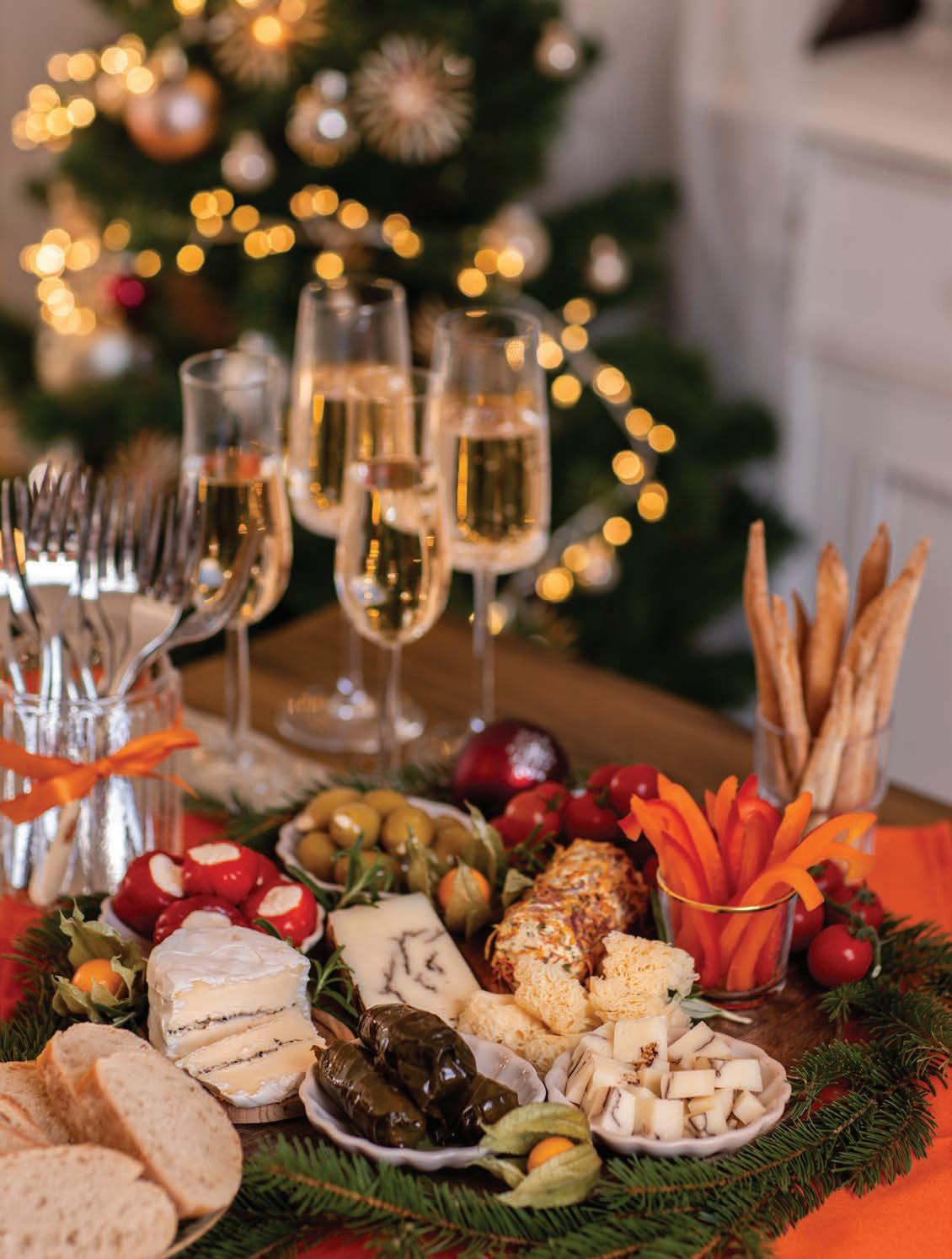
64 C entral Virginia HOME Holiday/Winter 2022 LIVE elevated entertaining
n Be Your Own Guest. Plan a party you will enjoy, and your guests will naturally be at ease and feel welcome.
n Plan Ahead. Don’t leave anything to the last minute. That opens the door to forgetting something and becoming a harried host who doesn’t have time to enjoy the event. Prep as much as you can ahead of time. And if outsourcing or augmenting with delivery helps make it easier, go for it!
n Cocktails & Mocktails. A signature cocktail makes an event even more festive. But with more people forgoing alcohol, be thoughtful and choose a creative mocktail so all guests feel included.

n Don’t Forget Décor. Nothing sets the mood like party décor, but it doesn’t have to be elaborate. Fresh flowers, seasonal gourd arrangements, and other ideas set the scene without over complicating things.
n Map Out Your Meal. Consider the kind of party you want. Sit-down? Go for a menu that you can plate to impress. Buffet? Plan for self-serving party-pleasing dishes that will keep. It’s also fun to lean into seasonal produce to make the most of the latest harvest.
n Craft a Creative Menu. What better way to inspire entertaining than with creative recipes from new cookbooks spanning multiple cultures and cuisines. Here are a few that might inspire original menus for the party season.
ENJOY THESE NEW COOKBOOKS FOR HOLIDAY ENTERTAINING. THERE’S SOMETHING FOR EVERYONE, NO MATTER YOUR FRIENDS' OR FAMILY’S TASTES.
BonAppétit!
LEARNING KOREAN: RECIPES FOR HOME COOKING

 By Peter Serpico with Drew Lazor
By Peter Serpico with Drew Lazor
Michelin Star and James Beard Award-winning chef Peter Serpico reached back to his Korean heritage to develop more than 100 recipes that offer a new spin on the food of his homeland. His Instant Kimchi offers 11 different versions of the classic food – with scaled back heat to accommodate different family tastes. Some dishes perfect for fall include Acorn Squash Soup and Sweet Potato Noodles. Most Inventive Recipe: a tongue-in-cheek rendition of Korean Army Stew, taking American staples such as Spam and hot dogs and combining with kimchi and Korean noodles.
BREADSONG: HOW BAKING CHANGED OUR LIVES
By Al Tait and Kitty Tait
This father and daughter duo shares more than 80 recipes for making homemade breads — a hobby that took off during the pandemic and remains a popular pastime for home chefs. It was also a hobby that not only pulled Kitty out of a severe bout of depression but allowed the family to start their own bakery. Nothing will wow holiday guests like homemade Maple Bacon and Pecan Buns or Cauliflower Gratin Tarts. Most Inventive Recipe: Zatar, Feta and Honey Buns.

cvhomemagazine.com 65
HOLIDAY TIPS
PARSI: FROM PERSIA TO BOMBAY – RECIPES AND TALES FROM THE ANCIENT CULTURE
 By Farokh Talati
By Farokh Talati
The Parsi culture dates to the seventh century, when a small group of Zoroastrians fled persecution in Muslim-occupied Persia by settling in the coastal town of Sanjan in India. This unique blend of cultures gave rise to a culinary tradition mixing the foods and seasonings of two different but complementary cuisines. Some recipes well suited for holiday entertaining – with a twist – include Roast Leg of Lamb with Garlic and Turmeric and Masala Ma Dukkar Gos, aka Pork Chop Cutlet with ginger and masala spices. Most Inventive Recipe: Pink Elephant, a rosewater infused gin cocktail.




NISTISIMA: THE SECRET TO DELICIOUS VEGAN COOKING FROM THE MEDITERRANEAN AND BEYOND

 By Georgina Hayden
By Georgina Hayden

The Greek work Nistisima translates to “Lenten” – relating to fasting and, in this case, abstaining from animal products. The author therefore reaches back to the rich history of traditional vegan cooking from Greece, Cyprus, and other locales to bring dishes featuring seasonal ingredients. Whether serving a full vegan meal, or just healthy sides for a main course, some recipes to try include Crushed Coriander and Olive Potatoes or Spiced Roasted Okra, Molasses, and Herbs. Most Inventive Recipe: Prassinopita, a “green pie” recipe the author invented leveraging the technique of salting the greens instead of steaming or sautéing.
ESSENTIAL
 By Ollie Dabbous
By Ollie Dabbous
Michelin Star Chef Ollie Dabbous takes dishes back to the basics and then elevates them to offer a creative stable of go-to dishes that will wow dinner party guests. One of his more elaborate recipes include Roast Venison with Jerusalem Artichokes, Tarragon and Rye for a sit-down meal, while the more modest Crispy Chicken Wings with Smoked Paprika offers a fancier take on casual dining fare. Most Inventive Recipe: Carrot Tartare with Sunflower Seeds, Mustard, and Tarragon.
66 C entral Virginia HOME Holiday/Winter 2022 John Stewart Walker, INC 3211 Old Forest Rd Lynchburg VA 24501 BRINGING YOU HOM E ... Making dreams reality (434) 384.0873 laura@laurasimmswebb.com Holidays without the hale! Call ahead or order online. 434-384-2200 peaklandcatering.com GRAB AND GO 4327 Boonsboro Road chicken salad pimento cheese soups salads ham biscuits FAMILY SIZE CASSEROLES AND SIDES!
Here to help with what matters most to you
Here to help with what matters most to you
The Hoskins Group
The Hoskins Group
Merrill Lynch Wealth Management 1705 Enterprise Drive Lynchburg, VA 24502 434.485.8285 fa.ml.com/the_hoskins_group
Merrill Lynch Wealth Management 1705 Enterprise Drive Lynchburg, VA 24502 434.485.8285



fa.ml.com/the_hoskins_group
Merrill Lynch, Pierce, Fenner & Smith Incorporated (also referred to as “MLPF&S” or “Merrill”) makes available certain investment products sponsored, managed, distributed or provided by companies that are affiliates of Bank of America Corporation (“BofA Corp.”). MLPF&S is a registered broker-dealer, registered investment adviser, Member SIPC and a wholly owned subsidiary of BofA Corp.
Merrill Lynch, Pierce, Fenner & Smith Incorporated (also referred to as “MLPF&S” or “Merrill”) makes available certain investment products sponsored, managed, distributed or provided by companies that are affiliates of Bank of America Corporation (“BofA Corp.”). MLPF&S is a registered broker-dealer, registered investment adviser, Member SIPC and a wholly owned subsidiary of BofA Corp.
Investment products: Are Not FDIC InsuredAre Not Bank GuaranteedMay Lose Value
Investment products: Are Not FDIC InsuredAre Not Bank GuaranteedMay Lose Value
© 2022 Bank of America Corporation. All rights reserved. MAP4264780 | AD-09-22-0298
© 2022 Bank of America Corporation. All rights reserved. MAP4264780 | AD-09-22-0298 | 470944PM-0222 | 09/2022
470944PM-0222 | 09/2022
cvhomemagazine.com 67
|
Come Join Us
It’s the Holiday Season. In today’s culture, this can have different meanings to each person and each family. Oftentimes it can raise our blood pressure or cause us stress when we think about the hustle and bustle of the season. Holidays also evoke the nostalgia of simpler times and festive treats. Regardless, at the core of these holidays are principles that we should look to: gratitude, generosity, and new beginnings.
HOME premier profile 2022
These principles go back further than the holidays they are connected to… they can be found in the greatest story ever told: the Bible. Each year, it is our goal at Thomas Road to provide opportunities to celebrate, as well as avenues for people to give back.


For over 50 years, Thomas Road has produced a Christmas program that attracts attendees from all over Central Virginia and beyond. The Virginia Christmas Spectacular is a Broadway-style production that features your favorite songs from the season, dazzling choreography, and The Living Christmas Tree — with over 250,000 twinkling lights programmed to music. What many people aren’t aware of is that each year, the show is made possible by hundreds of volunteers from the church. Singers, actors, stagehands, and our talented production team all give thousands of hours to bring the VCS to life. It is an opportunity to celebrate the season and be reminded of the true reason

68 C entral Virginia HOME Holiday/Winter 2022
we celebrate: the birth of Christ! Virginia Christmas Spectacular is December 9-11. Tickets are available at TRBC.ORG/VCS
The Salvation Army Angel Tree first began right here in Lynchburg, Va. Since its beginning in 1979, Thomas Road has partnered with the Salvation Army to bring Christmas to kids all over the area. As a part of each Christmas season at Thomas Road, we offer various ways for people to be generous, not only with their money, but with their time. Whether collecting and filling boxes as a part of the Operation Christmas Child program, hosting special Christmas parties for the Salvation Army, or delivering gift bags to families in the area, generosity permeates the season!
Christmas Eve at Thomas Road is always special. We think it's important for individuals and families to pause from the hustle and bustle, gift-giving, and stomach-stuffing and remember the true reason we celebrate. Our Christmas Eve service is a reverent pause to remember and reflect on the true gift of Christmas: the birth of Jesus! This year, identical services will be held on Christmas Eve at 5 p.m. and Christmas Day at 11 a.m. We would love for you to join us!
Each year, when the holidays come to a close, new beginnings come into view. Whether it's getting in better physical shape or getting our financial house in order, the new year brings new goals that develop into new habits. We encourage every follower of Jesus to commit to daily Bible reading and prayer time. We have several resources available to help with this commitment. They are available on the MyTRBC app or the Bible app by YouVersion, where you can find reading plans developed by our very own team at Thomas Road. Simply go to the YouVersion app and search “Thomas Road Baptist Church.”
TAKE TIME THIS YEAR TO REFLECT ON THE MEANING OF THE SEASON AND BE INTENTIONAL ABOUT WHAT THAT MEANS FOR YOU AND YOUR LOVED ONES. IF YOU HAVE ANY QUESTIONS ABOUT OUR EVENTS DURING THE HOLIDAYS OR ARE INTERESTED IN SOME SPIRITUAL NEXT STEPS, PLEASE EMAIL US AT INFO@TRBC.ORG OR VISIT OUR WEBSITE: TRBC.ORG.



1 Mountain View Rd, Lynchburg, VA 24502

cvhomemagazine.com 69
BY CARTER HEALD BENDALL Photography by Michael Patch
For 43 years, Archer and Billy Hunt have made their home in a residence that’s been in the family for four generations. They raised their four sons here and now their nine grandchildren visit often, keeping the house young and alive.

70 C entral Virginia HOME Holiday/Winter 2022
Glitters GENERATIONS ADD HOLIDAY SPARKLE TO FAMILY HOME ALL THAT
Built to last
This elegant Georgian house was built in 1926 by Mrs. Hunt’s grandparents, Mr. and Mrs. W.J. Davis Bell. The firm of Craighill and Cardwell designed the house. Archer says that, “my grandfather was said to have worked very closely with the architects, and he had a vision of how he wanted the house designed.” He wanted there to be an open view from one end of the house to the other with a graceful hanging staircase that extended to the third floor. He also envisioned the wide foyer that reaches to the back of the house, framing a view of the mountains beyond.
When the house was built, the entire area was nothing more than pastures. In fact, Archer says her grandmother often heard cows mooing while in her kitchen, and no more than one or two cars passed by every day. To this day, even with all the modern houses built around them, Billy says they still have mountain views out of any window in the back of their house. The original teak, wide plank floors, as well as the elaborate chair rails and double crown moldings, are still found throughout the house.
Creating traditions
With a house so steeped in family history, Archer could not wait to start her own family Christmas decorating traditions. The Hunts always decorate early so that they have prolonged time to enjoy the season. Archer loves all things about Christmas and tries to create a magical, old fashioned Christmas setting. She loves to use real greenery combined with faux. She will spray holly, magnolia, seed pods, pines cones and nandina with silver and gold paint to enhance the holiday sparkle. Archer says, “I like for things to glitter. My family calls it my fairy dust.”

When you enter the front door, the Christmas magic begins. The banister that extends to the third floor is decorated with lighted garlands and embellished with gold ribbons and bows. Sprays of gold magnolia and olive leaves are also tucked in the garland. On the second floor landing, Archer has a new tree, done in blue and white chinoiserie ornaments.
Flowing off of the foyer, the living room is Christmas central and home to several family traditions. The most important part of the décor for the Hunts is the actual tree, nicknamed “Big Betty”
cvhomemagazine.com 71
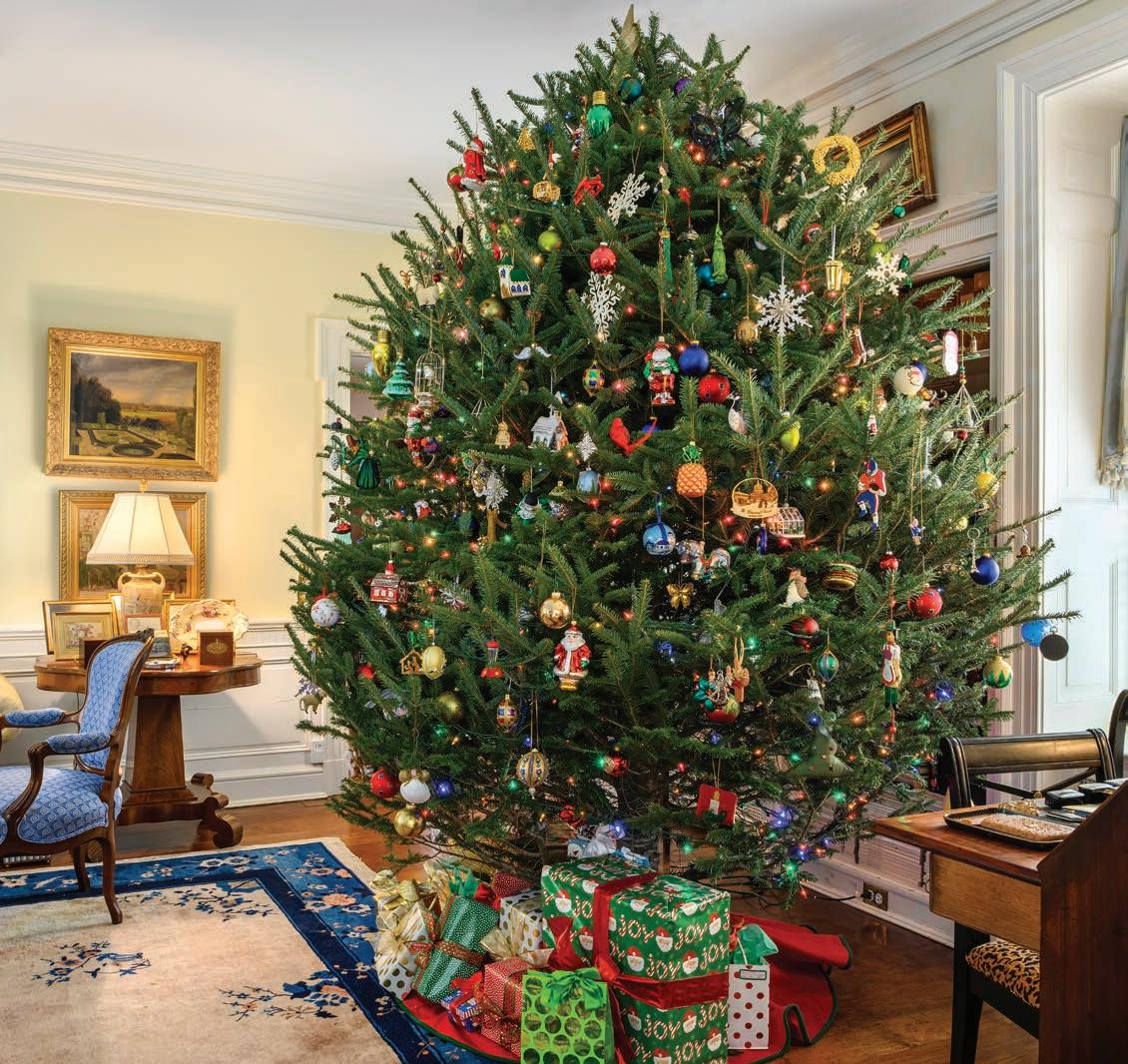



72 C entral Virginia HOME Holiday/Winter 2022
by Archer for its huge size. The Hunts order a tree every year from Virginia Garden Supply that stretches from the floor to ceiling, sometimes with little or no room for an angel at the top. Colored lights and collected glass ornaments adorn almost every branch of the tree. The tree resides in the living room along with a huge collection of Department 56 Snow Village scenes.
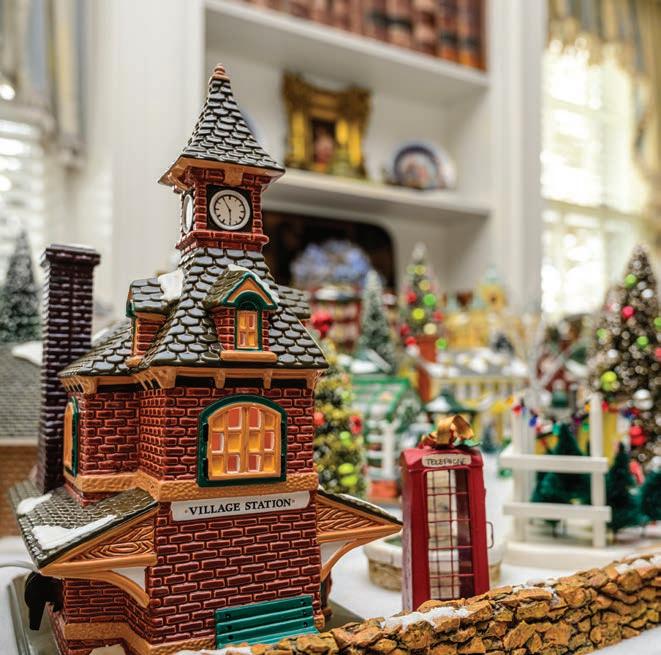
Archer was given her first Snow Village piece by her great friend Lalla Sydnor, who knew of Archer’s love of miniatures and dollhouses. Archer says, “Lalla was my Christmas angel who started the tradition of family and friends giving me more pieces to add to the collection.” The grandchildren love to help unpack and set up the village. Archer lets them be creative and decorate at will, even if it means townspeople figurines dangling from trees or faceplanted on the ice-skating rink. Anything goes.
The rest of the living room Christmas décor is done in green and gold tones that complement the American, English and French antiques in the room. The mantel a lush magnolia garland that is interspersed with gold ribbon, berries, pinecones and seedpods. A pair of gold topiaries and a gold angel round out the adornments on the mantel.

cvhomemagazine.com 73
Let in the light
Off of the living room through French doors is the sunroom. Above the French doors are a pair of antique terra cotta rams heads that Archer and Billy carried home from Paris in their suitcases. The Hunts line the sunroom walls with scenic watercolors from a Paris flea market.
This light and airy room houses Billy’s bottle opener Christmas tree. Over the last 30 years, his friends and family have given him and/or he has collected over 3,000 openers. Each year, the tree is decorated only with the openers he has received this year. This collection brings him joy as each one has a special memory of a trip or close friend.

Billy also has a collection of seashells and sea glass on the coffee table in this room that he has collected on vacations in the same way. The grandchildren even bring home shells for the table now. Archer jokes that when the table collapses under its own weight, then maybe he will have enough pieces, and that “Billy is the only person I know who has traveled all over the world and shipped home two boxes of rocks and shells.”
The mantel in this room is centered around a beautiful Italian papier mâché nativity set tucked into fresh magnolia, boxwood and gold ribbon. The first piece of the nativity was

74 C entral Virginia HOME Holiday/Winter 2022



cvhomemagazine.com 75

76 C entral Virginia HOME Holiday/Winter 2022
given to Archer by a close friend, and she has collected the other pieces little by little over the years. The Hunts fondly remember the day when their youngest son, Davis, as a little boy, pulled a chair up to the mantel and started playing with the crèche. Apparently when asked what he was doing he replied that “he was just playing with the God people.” Totally amused, Billy took him the very next day to purchase his own plastic set that he could play with more safely on a lower table.
The Hunts say that many of their collections are due to friends and family, and it’s one of the many reasons they love Christmas. They say, “Christmas makes us stop a minute and remember our friends and family and makes us realize how grateful that we are to have had them in our lives.”


Holiday dining
On the other side of the foyer resides the dining room. At Christmas the dining room table is covered in a white tablecloth that was custom made by an artisan in France, and then Archer ties a big red ribbon around the entire table with bows on all four corners. She says, “Christmas is a gift and this is how I symbolize it.”
At any other time of the year though, she adds, guests can see the divets in the table from four boys playing ping pong on it. Not to be outdone by the table, the walls in the dining room are one of the most memorable parts of the house. They are covered in scenic French wallpaper depicting flora and fauna from all over the world by
cvhomemagazine.com 7 7


78 C entral Virginia HOME Holiday/Winter 2022
famous French woodblock artist Jean Zuber. The colors have mellowed and darkened over time, and Archer says it feels like sitting in an oil painting. When the house settled a few years ago, a crack appeared in the mural walls. The grandchildren asked Archer about it, and in her typical form, she tells them it’s part of the mural — lightning from a terrible storm.
The centerpiece of the dining room table is a peacock figure that Archer hand made. Peacock feathers emerge from a body made of grapevine. Archer found inspiration for the peacock from the wallpaper.
Christmas china sits atop gold chargers and the family sterling silver flatware and candlesticks also add shimmer to the table. Waterford goblets reflect light around the room as well. The family tries to have Christmas Eve dinner here every year.

Off of the dining room, the breakfast room has a special treat for the grandchildren.

cvhomemagazine.com 79

80 C entral Virginia HOME Holiday/Winter 2022
Archer uses the table here to stage a hot chocolate and dessert bar, proving just how much this house is about family. A silver platter holds a sterling pitcher with cream and sugar. Other vases hold candy canes for dipping and cake bites for nibbling. What child wouldn’t love this? Wreaths and miniature trees round out the décor in this room, adding to the lovely mixture of watercolor art on the walls, some done by Archer herself.


The Hunt’s home is loved and cherished by all members of their family, but also by their friends. Archer says, “Christmas is such a magical time of year. It evokes happy memories and traditions of family and friends. We are always reminded of the true meaning of Christmas and celebrate the joy and love that it represents.” Their house is filled with not only lovely items but also beautiful stories of kindness and friendship. Many say, “all roads lead home at Christmas,” and if you are lucky, your road may lead to this house. ✦

cvhomemagazine.com 81
BOOST YOUR BUSINESS IN 2023

Reach more customers through strategic marketing with HOME magazine and WLNI
As you plan your marketing strategy for 2023, meet with us to reach a wider audience with HOME magazine and WLNI. These two mediums offer a unique way to bundle your messages to reach a larger audience in different ways. Both are hyper local, focusing ads and content to our local community and both are targeted to adults with the disposable income to afford your products and services.
While HOME magazine allows you to SHOW potential customers your products and services, WLNI offers you the ability to TELL your story in your own voice.
Let’s partner to boost your business! And you can experience success like Bass Sod Farm, Fortress Foundation Solutions, Kidd’s Restoration and Cleaning Services and L.G. Flint.
James River Media 109B Tradewynd Drive, Lynchburg (434) 845-5463 sales@jamesrivermedia.com

“We’ve had a lot of feedback from folks who have seen us in the magazine and heard us on the radio. We actually just got one call the other week, one job, paid for a whole year’s worth of our advertising. We’re very, very pleased with our advertising.
I know we get a lot of people that hear our ads on the radio, plus they’ve got the magazine to go back to look it up.
Rich came to me with the idea of putting it on both (WLNI and HOME magazine) … I thought that was a great idea, and we’re 100 percent glad we did go that route.”
W.B. Bass | Owner Bass Sod Farm

“We have been working with James River Media for over a year now and not only have improved our brand awareness, but we have seen direct results (almost a 300% ROI). It makes us smile when we hear customers say, “We heard your All Things Basementy ad on WLNI or we saw you in HOME magazine.” The team at James River Media always makes us feel comfortable when we are working on our commercials or ads. They truly help take my thoughts and put them into reality, even when they are a bit ridiculous, they simply respond and say…YEP!”
Laci Harvey | Customer Care & Marketing Director Fortress Foundation Solutions

“Our company, Kidd’s Restoration and Cleaning Services, has utilized both the HOME magazine and WLNI as an advertising medium for years. They effectively reach our customer base. This is always confirmed by the number of times I will run into people and they will say, “I saw your ad in the HOME magazine” or “I heard you on the radio.” Both WLNI and HOME magazine are both instrumental in what we want to achieve for our brand awareness.
HOME magazine hits the visual side of our advertising and WLNI obviously hits the listening side. They complement each other. I am a fan!”
Dan Taylor | Owner Kidd’s Restoration and Cleaning Services
“We have people let us know all the time that they heard our ad on WLNI or saw our HOME magazine ad. Furthermore, we have noticed an increase in qualified leads indicating that they found us by our ads with James River Media. That lets us know our advertising dollars are working. We appreciate that we have a marketing platform combining radio and print advertising that focuses on our local market.”
Ron Blackwood | Vice President L.G. Flint

 PHOTO: CURTAINS, BLINDS & BATH
BY PAULA PETERS CHAMBERS
PHOTO: CURTAINS, BLINDS & BATH
BY PAULA PETERS CHAMBERS

AAs temperatures begin to fall, the blankets and throws found in your home can take on greater importance. While these accessories can be overlooked, they are a great way to brighten a room, update a space, add visual interest and texture, and keep everyone comfortable on chilly days.

cvhomemagazine.com 83 DESIGN get cozy
IN THE THROW OF IT A bevy of blankets to keep everyone comfortable this season
Mady Greer, interior designer at Curtains, Blinds & Bath in Forest, notes there are differences between a decorative throw and a comfort throw, with decorative throws typically more delicate than those used for snuggling. “Every now and then, you hit the jackpot and get two in one,” she says. “Most of my customers want fashion and function. You have to decide what’s best for you.”
When thinking about complementing or elevating a home’s décor, Greer advises coordinating blankets with throw pillows and even investing in a fancier throw, for high impact. “You can find a specialty piece that maybe isn’t going to be the easiest to take care of, but will add so much oomph and presentation to your décor,” she says, pointing to mohair as a luxury texture that requires extra care but is deliciously soft.

Another way to heighten a room’s appeal, especially if the space follows a neutral palette, is to add texture. Throws that are boucle or knotted bring layers of visual appeal that won’t clash with what you already have. Greer says 100% cotton throws are always popular, especially those with tighter weaves that resist pulls from fingers or pet claws. “Cotton is harder to pull apart [than more delicate fibers] and is washable,” she notes. “It’s more expensive than a microfiber throw, but it has a whole different quality and look and is well worth the investment.”
Greer also advises customers to have a variety of blanket weights on hand. “Everybody has a different internal temperature,” she says. “It’s so important to keep whatever is comfortable and functional for each member of your family.”
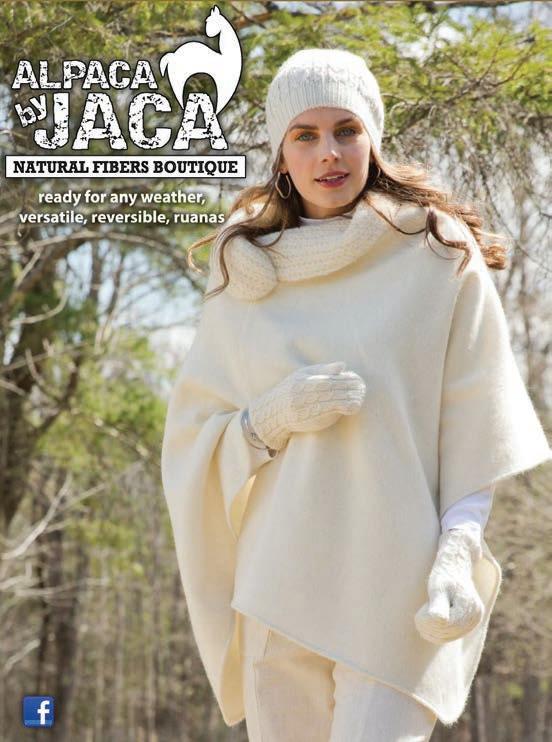



But they don’t all have to be on display. While Greer recommends intentional placement – check out Instagram for ideas – some just need to be close at hand. “Maybe keep one out that goes with your color story and adds texture, and the others can be in a basket right beside the couch,” she says.

84 C entral Virginia HOME Holiday/Winter 2022 1213 Long Meadows Drive Lynchburg (434) 237-3009 ValleyViewRetirement.com 34 years in business independent & assisted living no endowment or move in fees warm & friendly, home-like atmosphere exceptional activities program month to month leases award-winning community vibrant & worry-free senior living RIVER RIDGE MALL, across from JOANN 434.942.4005 AlpacabyJaca.com - shop 24/7
PHOTO: CURTAINS, BLINDS & BATH
PRO TIP

Alex Wood, who co-owns the Farm Basket in Lynchburg with her husband, says she finds customers are buying throws for themselves as well as others. Blankets make great gifts for weddings, new homes, and graduations.
“The trend is not to be trendy,” she says, noting that the most popular throws in her shop are those in earth tones, powdery pastels and soft colors. Popular and easy-to-style patterns are simple and classic, like window pane and herringbone.

Plus, it’s now possible to find blankets that are eco-friendly. The Farm Basket recently added a line of throws made from recycled materials. “They’re super soft, and you wouldn’t know they include recyclables,” Wood says.


Season
cvhomemagazine.com 85 2008 Langhorne Road • 434.528.1107 • thefarmbasket.com • Store Hours: Monday–Saturday, 10–5
CELEBRATING THE
WHAT SHOULD I DO WITH A THROW THAT HAS SENTIMENTAL VALUE, BUT DOESN’T WORK IN MY SPACE?
“IF YOU REMEMBER YOUR GRANDMA MAKING AFGHANS, SAVE A PIECE OF IT AND MAKE IT INTO A FRAMED PIECE OF ART. YOU DON’T HAVE TO KEEP THE WHOLE THING.”
— MADY GREER, INTERIOR DESIGNER AT CURTAINS, BLINDS & BATH
When it comes to updating or tweaking a room’s look, Wood says blankets are an affordable way to make a change.

“We went through this big gray, sleek, modern [look],” she says. “Now people want something to cozy up those rooms. And if you have a tighter budget, putting a throw on the back of a sofa or on the end of a bed is an easy way to give impact without a great investment.”
Wood points to throws made of cashmere blends and soft wool as options that feel luxurious but won’t break the bank, cost-wise. “If you spill on them, and it’s a blend you can’t throw in the wash, you’re not going to have a heart attack,” she says, recommending that customers be thoughtful about their goals.
“There’s functionality and also the look and the feel [throws] give a room; you’ve got to purchase with those uses in mind,” she says adding that in her own house, she has a blanket in a little-used den that just sits. “I invested in it, and it’s a focal point and it’s pretty, but it’s not functional. We are all thinking about that a little bit more – not just decorating with stuff.”
If a throw no longer matches your home’s style, it can be moved to another location or donated, if its condition is acceptable.

Both Wood and Greer agree there comes a time when a blanket or throw should be replaced. “A well-made blanket should last,” Wood says. “When tassels or fringe start unraveling or look dirty, or when you see pills, that’s when it’s time.” ✦

86 C entral Virginia HOME Holiday/Winter 2022
COMMUNITY FOCUSED. CLIENT DRIVEN. Always ready to assist with your real estate needs.
3211 OLD FOREST RD., LYNCHBURG 434-385-6655 JOHNSTEWARTWALKER.COM






cvhomemagazine.com 87 find your perfect vintage (434) 845-0555 1301 Main St. Lynchburg WISHING YOU A WONDERFUL AND PEACEFUL WINTER SEASON! Add a touch of artful personality to your home each season with coordinating products for every season and every reason! 434.847.0576 Mon — Sat: 9:00-4:00 • Sun: 11:00-4:00 1716 Main St. • Downtown Lynchburg Home Décor Flags • Gifts READERS’ FAVORITES AWARDS 2021 READERS’ FAVORITES AWARDS 2022 Shop Loc al, Shop Accents
GARDEN for the birds
A WINTER WONDERLAND OF BIRDING WHAT BEGINNERS NEED TO KNOW
 BY BECKY CALVERT
BY BECKY CALVERT
Birdwatching, otherwise known as birding, is an increasingly popular past time. There’s something slightly soothing in the practice that to begin, requires nothing but your attention.
Of course, as one’s interest in birding deepens, you can certainly invest in guidebooks and binoculars, perhaps even a fancy digital camera, but to set out to birdwatch, one only needs to stop and watch the winged creatures already flitting about. And then, once you’ve gotten hooked on the habit, you’ll find yourself looking for birds everywhere you go.
88 C entral Virginia HOME Holiday/Winter 2022
Getting started
All it takes to begin birding is a willingness and a curiosity to observe the outside environment, with a little bit of patience as you become familiar with bird habits. Birding is an activity that can be done almost anywhere, although some areas are better suited for spying a wider variety of birds. Time of day, season and weather can also affect the types and birds you will see. While many birds migrate in the spring and fall, winter is still an excellent time to go birding. The lack of foliage on trees allows more visibility of seasonal visitors you might not see at other times of the year.
You can begin by getting to know the birds in your immediate neighborhood. A spot where birds can find food and water does much to attract them, as does a habitat that provides shelter from the weather. Birds prefer a slightly messy environment – they love a good brush pile or a flower bed left to winter over with unraked leaves and flower heads gone to seed, as that provides them with cover as well as food sources.
Feeding the birds
You can set out food for the birds, preferably in a covered feeder that keeps rain and snow out of the food. High fat foods, like black oil sunflower seed, peanuts, thistle seed and suet are best
for feeding birds in winter. Place the feeders close to brush or another protected area like evergreen shrubs or trees – this can help protect the feeder from the worst of winter weather, while also giving the birds a quick escape from any threats.
Having the feeder in a protected spot near the house can also allow you to watch the birds from the comfort of your own home, especially as you begin to get to know your feathered neighbors. It’s important to regularly clean the feeders, as they can spread diseases between birds. You may want to consider deterrents for other pests that may be attracted to either the bird seed or the birds themselves, like squirrels, bears, chipmunks, stray cats and other pests.
Birds won’t require to be fed once the weather warms up and spring blooms, so you won’t need to leave your feeders out all year long. Plant native flowers, shrubs and trees in your garden to make your yard a bird-watching oasis all year long.


Fresh water is another requirement for attracting birds to your winter yard. A heated birdbath isn’t a bad idea, but just a dish kept clear of ice in cold temps works just as well. Like the feeders, it will also need to be cleaned and refreshed regularly. Keeping birdhouses or other nesting boxes up throughout the year also welcomes birds to your yard in cooler weather.

cvhomemagazine.com 89
Beyond the yard


Of course, you can also go outside your yard to watch birds. When bird watching in winter, you’ll want to dress for the weather, in colors that blend into the surroundings. Station yourself where two habitats meet, like the edge of a forest or meadow or a shoreline and just begin to observe. It can be helpful to not move around much, as sudden movements can frighten birds into hiding.

The cooler air of mornings carries the songs of birds farther, so there can be a wider variety of birds to be identified during that time of day. You may even discover birds you can hear but can’t see. The same can be true in the evenings, when the darkness hides the presence of birds you can’t see but certainly hear, like owls. While mornings are generally considered a great time for birding, one doesn’t have to be an early riser to be a bird watcher. There is plenty of activity throughout the day to take notice of.
Many birders like to keep notes of the birds they’ve seen and where they’ve seen them. There are both field guides as well as apps available to help one identify various birds on one’s own while area groups such as the Roanoke Valley Bird Club and the Lynchburg Bird Club host meet-ups of birders. Another excellent resource for local birders is Birding Virginia, which offers local and regional information on birds.
Once you begin paying attention to birds, you’ll probably start noticing other subtle changes in the natural environment around you. Birding is one of those gateway activities that may lead to you spending more time outside, observing your surroundings — a winter wonderland filled with interesting creatures.

90 C entral Virginia HOME Holiday/Winter 2022
BIRDS OF A FEATHER
BIRD CLUBS ARE A WEALTH OF INFORMATION FOR BIRDERS. THEY’LL CONNECT YOU WITH FELLOW BIRD ENTHUSIASTS, CAN HELP YOU IDENTIFY BIRDS, HELP TRACK WHAT’S CURRENTLY PASSING THROUGH THE AREA, POINT OUT THE BEST BIRDING SPOTS, ORGANIZE FIELD TRIPS AND SO MUCH MORE.

Birding Virginia (birdingvirginia.Org) is a statewide organization that offers information about birding throughout the state, including a list of birding hot spots in every area.


The Lynchburg Bird Club



(https://sites.Google.Com/a/lynchburg.Edu/ lynchburg-bird-club/home) holds monthly meetings September through May, on the second Wednesday of the month, at 7 p.m. in Room 315 of Martin Hall on the campus of Randolph College. ✦

cvhomemagazine.com 9 1 Soils, fertilizers, and amendments from Foxfarm, Coast of Maine, Espoma, Gaia Green, Dakind 420, Down To Earth and many more Huge selection of bird feeders and bird seed Animal feeds from New Country Organics, Tribute Horse Feeds, Diamond Dog & Cat Foods and others Local honeys, produce (seasonal) and Virginia’s Finest Foods Unique gifts Lawn & garden supplies and plants 16075 Forest Rd, Forest (434) 525-1007 georgesgrowshop Formerly Aylor’s














92 C entral Virginia HOME Holiday/Winter 2022 DestinationBedfordVA.com Shop downtown this holiday www.traipse.co/bedford A NEW, FREE AND FAMILY-FRIENDLY APP Find great downtown bedford businesses this holiday season with the traipse app
ere Ordinary Ends... Bedford Begins.










cvhomemagazine.com 93
Creative Pursuits
Try your hand at a new hobby this winter
 BY MITZI BIBLE
BY MITZI BIBLE
It’s scientifically proven that carving out “me time” can improve our mental health. When we fill it with hobbies, we can find ourselves being whisked away from the regimented world around us and allowing our creativity and imagination to run free.
The slower winter season may be a chance for you to get your creative juices flowing and take up a new hobby. Below are five hobbies with tips and resources for getting started. In the end, you may discover a hidden talent and passion you never knew you had.
94 C entral Virginia HOME Holiday/Winter 2022
Photography
Lisa Pitcher has been pressing her shutter button for 40 years. She has amassed countless snapshots of Lynchburg landscapes, wildlife, people and events. While some photos she took as a business professional, most of them were simply as someone who loves the art of photography.



“Photography is a good hobby to motivate you, to keep you going and active,” she said. “It’s also a good way of recording where we’ve been, who we are, and what we like.”
Pitcher is the president of the Blue Ridge Photographic Arts Society (BRPAS), a group that has been meeting monthly in Lynchburg for about 20 years.
“Some of us are professionals, and some just want to learn how to take better pictures of their grandkids,” she said. “As a group, we try to help others find their vision for their photos.”
It’s less about the technical aspect and expensive equipment. Many members prefer to shoot with their smartphones.
“With today’s photography, you don’t need to sink a lot of money into it, and you don’t have to have the latest and greatest to take a great photograph,” Pitcher said.
The encouragement and support from her photography family stretches her as an artist. The group holds photo contests and critique sessions, and they meet for “dine-in shoots,” taking photos at different locations before enjoying a meal together. “It’s like having a date with your camera,” she said.
cvhomemagazine.com 95
PHOTO: BRUCE WARD
The group has been to local gardens, parks, Hillcats games, graveyards, and even on an occasional road trip to New York City and Washington, D.C.

She advises beginners to start by researching famous photographers they like and allowing their photos to influence their own work. Pitcher also suggests online tutorials and classes on basic photography, many of which are free. “It’s about educating the eye,” she said.
The Academy Center of the Arts regularly offers beginning photography classes (go to Academycenter.org and click on “education”).

Music
Maybe you took lessons as a child but had to give them up when school, sports or a job begged for your time. Or maybe you’ve never held an instrument but always wanted to play piano or guitar so you can lead family sing-alongs.

Many people find that learning a musical instrument as an adult comes with more freedom than it does as a child. There are no tryouts or auditions and no pressure to perform for audiences. Plus, studies show that playing an instrument can preserve memory function, so it is never too late to take up the world’s universal language.



But where do you start as an adult? The same place you did as a child — with lessons and practice. Many local music stores offer education programs for all ages, and local professionals who give private lessons to children are pleased to welcome adults. It’s also fun to share music with those you love, so ask a child or grandchild who plays an instrument to teach you the basics. (Musical talent can be hereditary, so you may have more in common than you know.)
If you’re interested in sharing your passion for music by blending your
96 C entral Virginia HOME Holiday/Winter 2022 there’s no place like HOME When you want to reach the most responsive, most affluent, most desirable audience in Central Virginia. KIRSTEN FOR ADVERTISING INFORMATION CONTACT Kirsten Morey Becker 434.238.3168 kirsten@jamesrivermedia.com Joe Katany 434.907.6872 joe@jamesrivermedia.com Kenny Shelton 434.258.3350 kenny@jamesrivermedia.com JOE
voice with others, join a choral group. The Jefferson Choral Society is the oldest and largest volunteer adult choir in Central Virginia (visit www.jeffersonchoralsociety.org for information). You may also consider joining a church choir and finding solace in worship and fellowship.
Cooking
Most of us have made it to adulthood with basic cooking skills, but some of us may long to cook our restaurant favorites or entertain guests with fare more exquisite than our weekly chicken casserole. TV cooking shows have become popular for this reason, and if you’re a regular viewer, you have probably felt challenged by those brazen chefs who make cooking look easy.

But choosing cooking as a hobby can be one of your most beneficial endeavors. It can cause you to take more interest in your family’s nutrition, and it can open the door to explore other cultures.


Taking a class may be the first step. Lynchburg Parks & Recreation regularly offers adult culinary classes, some with special themes like a couples dessert night or how to make hot sauce (visit LynchburgParksandRec.com for upcoming classes). And many companies, such as ClassBento, offer online-based workshops where you order a kit with all the ingredients sent straight to your door. You can interact with a private instructor online as you cook. Classes are offered in Thai, Indian and European food.


A personal challenge to heat up your new hobby and expand your palate is to choose one ingredient a week that


Thank you for voting!
cvhomemagazine.com 97 huckleberryknobnursery.comlynchburglawncare.com LAWN & LANDSCAPE MAINTENANCE GARDEN SUPPLIES & ACCESSORIES NURSERIES LANDSCAPE AND HARDSCAPE DESIGN & BUILD
lynchburglandscapes.com
you’ve never cooked with before. It may be a vegetable, a type of pasta, a meat or fish, or even a new sauce. Commit yourself to cooking with at least one new-to-you item every week.
Another idea is to throw a cooking party. Ask a friend who knows their way around the kitchen to serve as host and give you pointers. Spend time preparing a full meal with your friends and then reap your rewards at the table together.
Pottery
Pottery may be one of the earliest hobbies. There’s something primal and soothing about working with clay. Kelli Johnson, Education Manager for the Academy Center of the Arts, said the center’s weekly Pottery Night Out has become one of its most popular events. The one-time, two-hour class is typically held on Friday nights and allows people to try their hand at the potter’s wheel and take home a finished product. The center also offers a Beginning Hand Building class (how people formed clay before potter’s wheels were invented), so you can test your raw skill. Other multiple in-studio classes are offered for different ages and skill levels.
Johnson said many of the center’s art classes (painting is also popular for adults) start off at four weeks: “So the great thing is you’re not investing your entire life trying to learn it — if you don’t like it, you can go and try something else.”
Lynchburg Parks & Recreation also offers pottery classes for all levels as well as family pottery events.
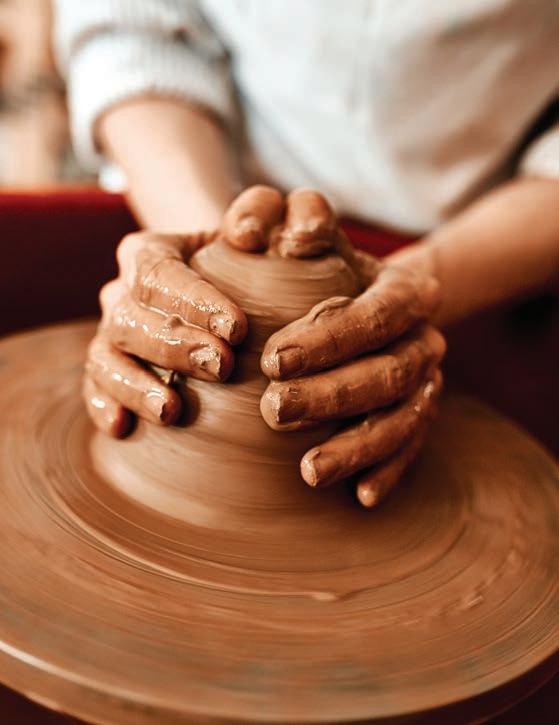
If you want to venture out on your own, many companies sell adult DIY pottery starter kits online, complete with clay,
GLEANING
Visit us at www.gftw.org

98 C entral Virginia HOME Holiday/Winter 2022 FOR THE WORLD
FOR THE WORLD
tools, and instructions for everything from vases to mugs to trinket dishes. Sites include sculpd.com, noahsbox.com and crockd.com.

Needlecrafts
You may have tried needlecrafts years ago, or maybe you always watched your grandmother from afar, but it is making a resurgence. Now could be the time to try cross-stitch, needlepoint, embroidery, knitting, quilting, or the close cousin of needlecrafts: crochet.


One of the best things about needlecrafts is that you can take your projects with you wherever you go. How many times do we find ourselves waiting for something: Waiting for a doctor’s appointment, sitting in a carpool line, traveling by plane or train, or simply waiting for the tiredness to kick in before bedtime.
Needlecrafts can be therapy, too. The back-and-forth rhythm of the stitching is calming.
Cross-stitch and needlepoint are perhaps the easiest places to start. Local arts and crafts stores stay stocked with patterns, traditional and modern. Both crafts call for making art out of stitches on fabric; cross-stitch uses mainly x-shaped stitches, while needlepoint tends to be more intricate and involves a variety of textured stitches. Needlepoint enthusiasts today are decorating belts, clutch purses and even shoes. Beginners should start off with something small, like a Christmas ornament, and build their way up to larger designs.
While needlecrafts can certainly be done solo, local groups have formed for people to set aside dedicated time for their projects and feed off each other’s creativity. Lynchburg Parks & Recreation hosts a “Knit or Knot” knitting group, and Campbell County offers the weekly Needlecrafters group and Pins & Needles group. ✦
cvhomemagazine.com 99





100 C entral Virginia HOME Holiday/Winter 2022 FAMILY-OWNED SINCE 1921 Call us direct or ask your landscaper or contractor to install the best! 434-219-2277 | basssodfarm.com FEATURING Virginia’s Finest Certified Fescue H Haappy Holidays from all of us at Bass Sod Farm! RESIDENTIAL AND COMMERCIAL DELIVERY | SOD INSTALLATION lookatmybooks.com 434-239-1989 • 630 Wyndhurst Dr. • Suite F • Lynchburg Is your business in trouble? Are you behind on your taxes? Are you completely overwhelmed and don’t know where to turn? Since 2001, Small Business Accounting has worked with small and medium sized businesses across the US to flip their business around from losing to gaining profits. We focus on accounting for your business while strategically solving tax issues with the IRS and states. SERVICES INCLUDE: You’re not alone, we can help. ● Accounting and Business Consulting ● QuickBooks® ProAdvisor ● Bankruptcies ● IRS Collections ● State Tax Resolution ● Years of Unfiled Tax Returns ● Financial Planning
CHRISTY PHILLIPS
“The Queen of Money Messes”
Hero
Be a cookie swap Beyond the peanut butter blossom
BY SARAH NICHOLAS
It’s cookie baking season y’all! Get out those aprons, here comes some cookie inspiration. No matter what your age, who can resist a cookie?
When winter rolls near, we all start dreaming of making cookies with kiddos and destroying our kitchens in the process, but who cares! Some of you may partake in the tradition of a Cookie Swap, and we are here for it. Not to point any fingers, but are you tired of seeing the same chocolate crinkles, iced sugar cookies and peanut butter cookies with Hershey’s® Kisses®?
It’s OK, we get it, and we are here to up that cookie game. These cookies are fun and easy with elevated ingredients that may surprise you and will certainly make you top contender for cookie swap hero this year! Word of caution, one is only for adults, but who said kiddos get to have all the fun?

cvhomemagazine.com 101 LIVE delicious treats
BOOZY DARK CHOCOLATE CHUNK COOKIES OK, who is on board with an adults-only cookie? This cookie is drool-worthy and made especially for nostalgic adults who crave some chocolate chip cookie goodness!

2 cups all-purpose flour

1 teaspoon baking soda

1 teaspoon baking powder
1/4 teaspoon salt
1 cup dark brown sugar, tightly packed
1/2 cup salted butter (melted)
1 large egg
1/4 cup bourbon

1 1/2 teaspoons vanilla
2 cups dark chocolate, chopped 2 teaspoon orange zest Sea salt for sprinkling
In a large mixing bowl combine flour, baking soda, baking powder and salt. Whisk together until fully blended. In a different bowl, combine brown sugar, butter, egg, bourbon, and vanilla. Whisk together until fully blended and smooth. Add the dry ingredients to the wet and mix again until well combined. Lastly, fold in chocolate chunks and orange zest. Cover the bowl and chill for one hour. While chilling, pre-heat your oven to 350°F and lightly grease two cookie sheets. Using a 1 tablespoon cookie scoop, scoop out the chilled dough onto the cookie sheet and sprinkle with sea salt. Bake for about 10 minutes until the cookie’s edges are set, but inside is still a bit gooey. Devour!
102 C entral Virginia HOME Holiday/Winter 2022
SMITH MOUNTAIN LAKE H O M E This annual publication showcases local style—how we design, build, furnish, landscape and live in our Smith Mountain Lake homes. Our 2023 edition will be available in March. To receive a copy or to reach homeowners in this desirable market please contact sales@jamesrivermedia.com. READERS’ FAVORITES AWARDS 2022 (434) 376-2418 | www.francisoil.com Propane | Gas Logs & Heater Sales and Installation Gas Water Heaters | Fire Pits PROUDLY SERVING RESIDENTIAL AND COMMERCIAL CUSTOMERS IN CENTRAL VA SINCE 1956…
FANCY ALMOND & PISTACHIO SHORTBREAD

Shortbread is a classic and is so simple to make. Most of the time, you probably have the ingredients in your pantry. This version amplifies the buttery flavor of this classic cookie with almond and toasted pistachio. Great for a cookie swap, and they are even better after a few days!
16 tablespoons salted butter, at room temperature
1 cup confectioners’ sugar

2 teaspoons almond extract
1/4 teaspoon vanilla extract
2 cups all-purpose flour, sifted
1 cup shelled and raw pistachio, finely chopped
Preheat the oven to 300°F and lightly grease two 8” square cake pans. In a mixing bowl, beat together the butter, sugar and extracts until fully incorporated. Add the flour. (It may seem dry but keep beating, and it will come together.) Divide the dough in half and add each half into the cake pan. Gently press into the pans and sprinkle on pistachios, smoothing it out. Use a fork to prick the dough all over. Bake until light golden brown, about 30 minutes. Remove and cut immediately into 12 equal strips (per pan). It won’t cut as well cold. Enjoy!
cvhomemagazine.com 103 Children’s Dentistry & Orthodontics of Lynchburg www.smilelynchburg.com
ORANGE & ROSEMARY OLIVE OIL COOKIES
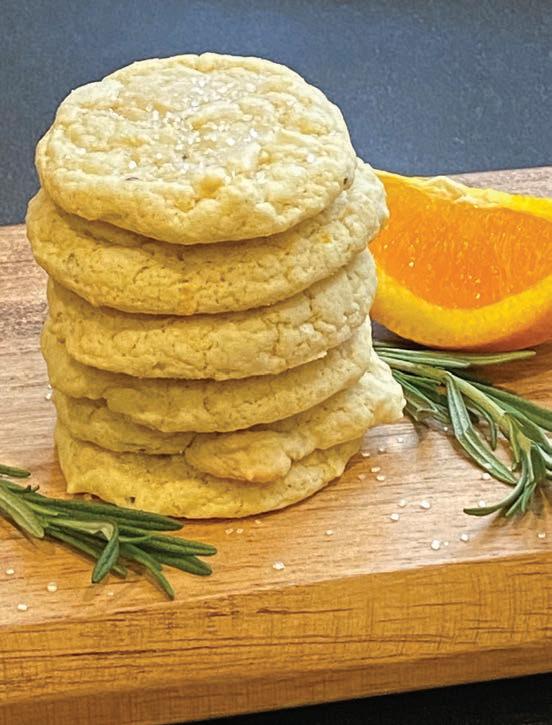
These cookies are a go-to every year around Thanksgiving but are honestly great any time of year if you are looking for something unique, pretty and oh-so flavorful. The little specks of rosemary shine through and combine sublimely with the orange flavor. They are a little sweet, a little tangy and herbaceous!
2 cups all-purpose flour
1/2 teaspoon baking soda
1/2 teaspoon baking powder
1/4 teaspoon kosher salt
1 cup sugar
1/3 cup confectioners’ sugar
1/3 cup olive oil
3 teaspoon orange zest
1 tablespoon orange juice, freshly squeezed
1/2 teaspoon finely chopped fresh rosemary
2 eggs
1/2 teaspoon almond extract

Sugar for sprinkling
Preheat oven to 350°F and line a cookie sheet with parchment. In a mixing bowl, whisk together the flour, baking soda, baking powder and salt. Using a stand mixer, beat both sugars, olive oil, zest, juice and rosemary until smooth. Beat in the eggs and almond extract. One cup at a time, add the dry ingredients, beating until combined.
Using a 1 tablespoon cookie scoop, scoop out balls and place on the baking sheet about 1 inch apart. Sprinkle with sugar. Bake for 10 to 12 minutes. Remove from oven and allow to cool on a cooling rack. Swoon! ✦
104 C entral Virginia HOME Holiday/Winter 2022 READERS’ FAVORITES AWARDS 2022
IN Hot water
3 THINGS TO KNOW ABOUT WATER HEATERS
BY JERRY HALE
Homeowners who’ve experienced a hot water outage know just how disruptive and inconvenient a dying hot water system can be. And while there’s never a good time for a water heater to fail, folks with the worst of luck have it happen when a house full of company is about to arrive for a long weekend.
So let’s explore the ins and outs of water heater longevity and replacement, with the goal of never having to shiver through a cold shower again.

cvhomemagazine.com 105
IMPROVE turn up the dials
Wishing you a very happy holiday season and
wonderful New Year.
How long do water heaters last?

Most experts say homeowners can expect eight to 12 years of life from a standard storage tank water heater, and over twice that from a tankless, on-demand heating unit. Variables that shorten water heater life include unusually hard or acidic water, location in an unheated space where it must work harder to achieve and maintain desired temperature, and amount of use — that is, how many people in a household are regularly taking showers and generating dishes and clothes to be washed.
An increase in instances of insufficient hot water is one sign a heater is at the end of its life span. Other hints of imminent failure include noisy operation (hisses and clunks), water puddles below the base of the unit, lime scale buildup on plumbing surfaces and odd-tasting or smelling hot water.
Water heater replacement parts are quite expensive, so attempting to resurrect a malfunctioning unit that’s eight or more years old is usually unwise. While replacing a water heater is not cheap either — think $1,500-$2,500 for a quality 75-gallon tank type and two to three times that for an on-demand unit — it does provide assurance of steady hot water flow for years to come. Natural gas or liquid propane-fired water heaters tend to have lower energy costs than electricity-powered units, and water heaters produced since 2014 must meet a government-mandated efficiency standard.
Maintenance needs vary by type of system, of course, but there some fairly easy tips online if you’re the handy sort. Most homeowners will have the skills and tools to accomplish these steps, but if not, a plumber can do it in a couple of hours.
106 C entral Virginia HOME Holiday/Winter 2022
a
FROM ALL OF US AT
Should I go tankless?

On-demand tankless units are all the rage in vacation home construction due to their longevity, ability to handle periods of high demand (i.e., lots of guest showers) and the fact that they aren’t consuming energy when no one is in residence.



“And we hear lots of initial interest in upgrading to on-demand from customers whose tank system has failed,” said Chad Angle, Service Manager at Wisler Plumbing. “But then reality sets in. That change-over, which does offer twice the life span, will have an initial cost of three times and up, and may require installation of a water treatment system for the homeowner to qualify for Navien’s (the brand Wisler handles) 15-year warranty. Meeting code requirements for air intake and venting of a gas-burning system can also add significantly to installation costs.”
Jason King, a master plumber at SML Plumbing, elaborates on the importance of water quality. “Just as excessively-hard or acidic water will cut into the life of a tank-style system, it will also impact longevity of an on-demand system. A water analysis should always be obtained to guide selection of and the maintenance schedule for a new system,” he says. “But I always start with a lifestyle assessment. A couple living mostly alone in a small cottage has very different water usage needs than a family of four or five that frequently hosts weekend guests.”
Another consideration mentioned by both professionals: Allelectric on-demand systems are not practical energy-wise. Notes King, “They draw two to three times the current of a clothes dryer, and few homes are wired to supply that. It takes a lot of juice to instantly heat water to shower temperature.”

cvhomemagazine.com TOTAL KI TC HEN TR ANSFO RMAT ION. Before After New Cabinets 540.274.3230 • kitchentuneup.comKitchen Tune-Up , serving Lynchburg and surrounding communities CORY DUGUAY Local Owner ©2021 HFC K TU LLC. All Rights Reserved Kitchen Tune -Up is a trademark of HFC KTU LLC and a Home Franchise Concepts Brand Each franchise is independently ownedand operated. 1 DAY TUNE-UP • REDOORING • REFACING CABINET PAINTING • NEW CABINETS Starting as low as $99-$249/month! FINANCING AVAILABLE 5 Ways to Update Your Kitchen
Is solar an option?



Perhaps, if your pockets are deep. According to angi.com, the basic parts for a solar water heating system run $1,000 to $4,000, depending on system capacity. Add an additional $1,000 to $2,500 for additional plumbing, backup heaters or switches to control the system. The number of solar panels needed also plays a role, costing between $800 and $1,500 each. Labor for the conversion may add several thousand dollars. Federal, state and utility tax credits and rebates may apply in some cases.





Your practicality calculations can assume a usable life of well over 20 years. Access to direct sunlight is critical to system performance, and a professional in this area will likely recommend a back-up heater as “hot water insurance” for cloudy weather and the shorter, colder days of winter. Remember that some communities may have covenants that govern roof-top installations. ✦

108
C
entral Virginia HOME Holiday/Winter 2022







cvhomemagazine.com 109 READERS’ FAVORITES AWARDS 2022 “Whatever you d, in a wd in a deed, d a in th nam o th Ld. ” Colossian 3:23
TAKE A TOUR OF BARN QUILTS
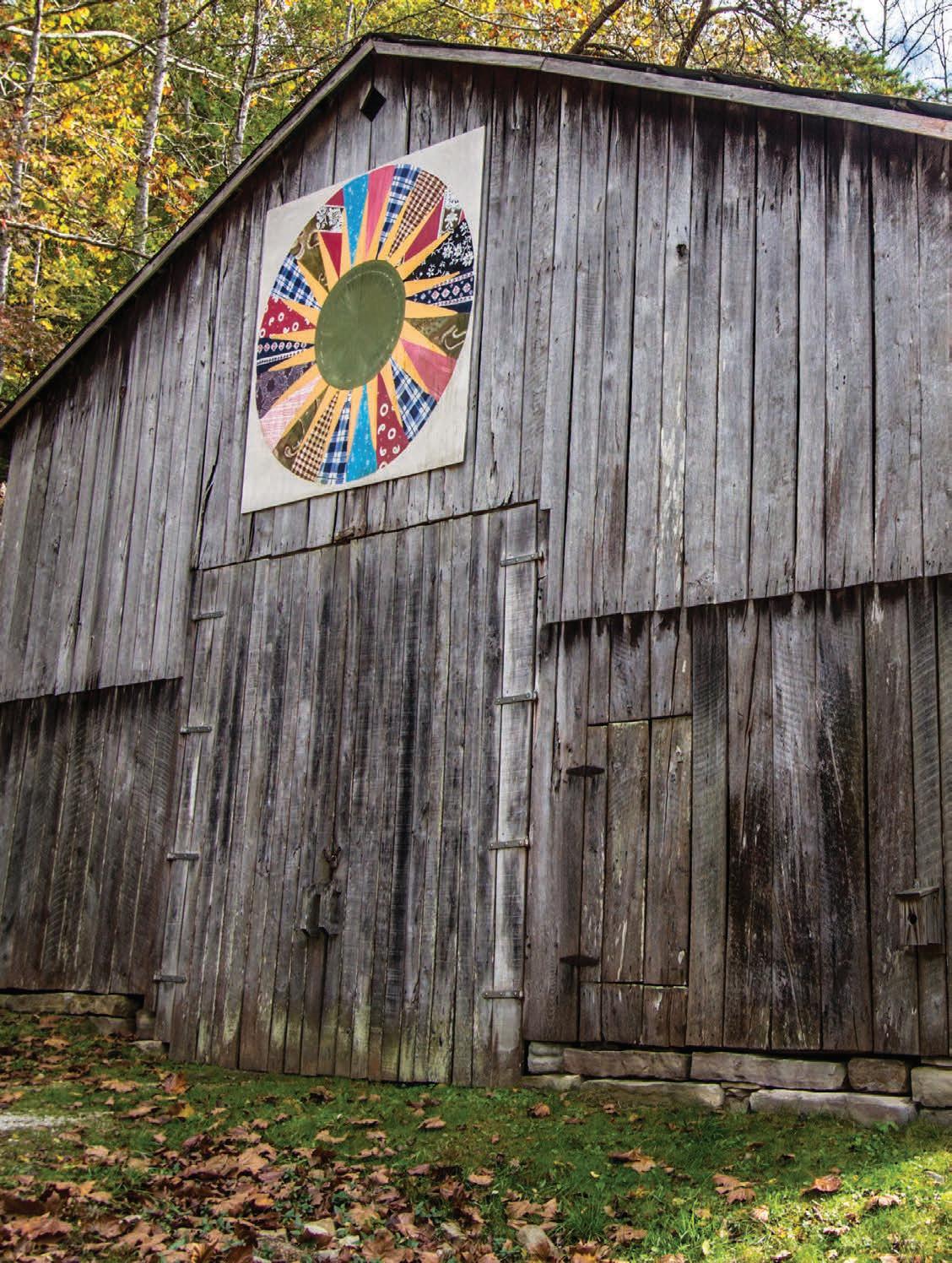
A CELEBRATION OF AMERICANA
BY KENDALL ATKINS LIVICK
Joining the ranks of “Americana” staples like apple pie, blue jeans, and the bald eagle, barn quilts have reclaimed an important spot in sentimentality. While quilt designs first appeared on barns up to 300 years ago, they’ve made a resurgence. For 20 plus years now, this art form has found a home in Appalachia and has made its way into the hearts of the people of the Blue Ridge and beyond.
110 C entral Virginia HOME Holiday/Winter 2022
LIVE take a tour
Quilting itself endures as a tradition brought over and inspired by English, Dutch, Irish, Scottish and German settlers. The patterns that remind us of Grandma and encourage us to cuddle up in cozy southern comfort, continue to greet the eye and provide enjoyment even for those who have never picked up a sewing needle.
What is a barn quilt?
Despite the name, “barn quilts” aren’t actually made of fabric, and they don’t necessarily have to be hung on barns. This newer art form, made of wood and paint, look strikingly similar, if not identical, to those reminiscent patterns of the past. This nod to our roots has evolved into a new form of rustic décor.
The regional epitome of barn quilt culture is the Blue Ridge Barn Quilt Trail of Greene County, Va. According to Greene’s tourism site, the barn quilt era rose in popularity starting in 2001 when an Ohio woman named Donna Sue Groves painted a meaningful quilt pattern on her barn to honor her mom. From there, other locals were inspired, and they too wanted to show off special quilt symbols that held meaning within their family tree.
As neighbors mimicked the style, the trend spread over the next couple of decades all across America. Patterns once displayed as textiles are now displayed as painted wooden blocks on barns and beyond — making the two concepts of barns and quilt patterns intertwined like peanut butter and jelly. They just fit.
Established in 2016, the Blue Ridge Trail, the most inclusive barn quilt trail in Virginia, features 145 barn quilt blocks, scattered around the countryside and displayed on barns, houses, sheds, porches, fences, mailboxes and even as garden


cvhomemagazine.com 111
PHOTO: GREENE COUNTY TOURISM
PHOTO: GREENE COUNTY TOURISM
THE
Listen to The HOME Show each Saturday morning at 9 a.m. on WLNI as HOME Editor Donna Dunn and Rich Roth along with HOME Publisher Trish Roth and Producer Ashley Schamerhorn bring HOME to life with a host of local experts and friends.
The HOME Show will feature interior design trends, home maintenance tips, gardening ideas, delicious recipes and more!


accoutrements. Businesses have also joined in the fun. The Blue Ridge Barn Quilt Trail celebrates this neighborly collaboration of rural folk art and invites locals and tourists to partake in barn quilt culture as they drive through the smattering of colors and geometric patterns.
Beyond the barn

You don’t have to actually have a barn to get in on this trend. In addition to the aforementioned structures of sheds, fences, and the like, you can even hang barn quilts inside your home. Why not display a sacred mural of some sort over the fireplace, on top of the bookshelf, in the office den, in a child’s nursery or in the farmhouse kitchen? A diversity of patterns make this a versatile accessory that could fit seamlessly in any domestic or outdoorsy space.
Next, decide whether you’ll hire an artist or DIY your own barn quilt. If opting for a DIY project, head to YouTube or Pinterest for step-by-step tutorials on how to measure, mark, select paint, and exercise precision in the execution of your pattern. You might start with a smaller version for the interior of your home to get a feel for the marking and painting techniques, before moving onto a larger project like a massive outdoor barn quilt.
Whether hiring an artist or undertaking the project as a solo or collaborative group effort, you’ll want to select a place to display the art and determine the size of your block. Go for sandboard or plywood if possible when making a traditional barn quilt. If aiming for the overall style on a smaller scale to be displayed in the interior of your home, a local craft store might have different suggestions for lighter weight materials.
Most importantly, choose a pattern that is personally meaningful. It could be from a quilt handsewn by your great-great grandmother, a symbol that ties into your family namesake, a hex sign with an inspiring meaning for protection or abundance, or simply a fractal of sacred geometry that appeals to your eye. Then display anywhere you choose and enjoy beholding your chosen piece of art and sharing the meaning with your neighbors and visitors.
Tune
112 C entral Virginia HOME Holiday/Winter 2022
INTRODUCING
in weekly for the Southern Landscape Group’s Outdoor Scoop, where we’ll discuss all things lawn, garden, pool and al fresco life! HOMEmagazineVA
PHOTO: RICHARD ALLNUTT
IDEAS FOR BARN QUILT ICONOGRAPHY




A family symbol
Nature images
Monograms
Dutch hex sign: A rosette for good luck, a dove for peace, an eagle for strength or a trinity of tulips meaning Faith, Hope and Charity

cvhomemagazine.com 113
n
n
n
n
✦
PHOTO: VIRGINIA DELK
PHOTO: HALIFAX COUNTY TOURISM


114 C entral Virginia HOME Holiday/Winter 2022 ADVERTISER indexLOCAL sources FOR ADVERTISING INFO: (434) 845-5463 JAMESRIVERMEDIA@GMAIL.COM 114 local sources special rates available A COST-EFFECTIVE OPPORTUNITY TO ADVERTISE IN HOME MAGAZINE. FOR MORE INFORMATION: 434-845-5463 JAMESRIVERMEDIA@GMAIL.COM Academy Center of the Arts................................................................................................................. 60 Accents……………………………………………………………………………………………………..........................………………………87 Acupuncture Works LLC………………………………………………………………………………..........................……………114 Agatha Interiors 92 Alpaca By Jaca……………………………………………………………………………………………………..........................………..82 American Moving and Storage………………………………………………………………………..........................………..44 Arthur’s Jewelry 18 Ashwood Manor 61 Bailey Grey...................................................................................................................... .......... 9, 48 Bailey Spencer………………………………………………………………………………………………………..........................………34 Bank of the James 26 Bass Sod Farm……………………………………………………………………………………………………........................…………100 Bedford County Tourism 92 Blickenstaff & Company, Realtors………………………………………………………………..........................…………….21 Bloom 49 Blue Lady 93 Bowen Jewelry Company…………………………………………………………………………………...........................……….87 BVA Mercantile 93 Children's Dentistry & Orthodontics of Lynchburg…………………………………..........................………..103 Collins Siding & Windows, Inc…………………………………………………………………………...........................………..12 Daniele Mason, Realtor…………………………………………………………………………………….................. .......……………21 Davies & Davies……………………………………………………………………………………………….........................………………..8 Decorating Den Interiors……………………………………………………………………………….........................…………….55 Dermatology Consultants...................................................................................................................... 113 DoorTek Garage Door Service.............................................................................................................. 23 Electric Co 93 Enchanted…………………………………………………………………………………………………………….........................………….87 Estates Revisited……………………………………………………………………………………………….........................…………..87 F&S Building Innovations………………………………………………………………………………...........................…………..10 Fabulous Finds 60 Farm Basket................................................................................................................................................ 85 Fink's Jewelers……………………………………………………………………………………………….........................…………………5 First Bank & Trust Company………………………………………………………………………...........................……………..18 Flint Property Group…………………………………………………………………………………..........................………………..42 Forest Farmers Market………………………………………………………………………………………..........................……….114 Forest Flowers & Gift Gallery 38 Fortress Foundation Solutions…………………………………………………………………………...........................……..47 Francis Oil………………………………………………………………………………………………………………........................……….102 Generation Solutions 36 George’s Feed, Seed, & Grow Shop 91 Gleaning for the World 98 Grand Home Furnishings……………………………………………………………………………………………...........................17 High Cotton 49 Isabella’s………………………………………………………………………………………………………………….........................……….48 Ivy’s……………………………………………………………………………………………………………………....................................…….15 James River Ironworks………………………………………………………………………………………… …….96 James River Media………………………………………………………………………………………………… ……..82 James T. Davis/Katrina & Co.................................................................................... ............. 53 John Stewart Walker 86 Just Liz……………………………………………………………………………………………………………………… ……..54 Kathy Terrell, Realtor ................................................................................................ ................ 62 Kevin Midkiff, DDS....................................................................................................... ................ 55 Kidd's Services............................................................................................................ .................. 34 Kitchen Crafters of Virginia.................................................................................... ............... 109 Kitchen Tune-up of Roanoke……………………………………………………………………………… ……107 L.G. Flint....................................................................................................................... ..................... 37 Land Tech Group………………………………………………………………………………………………… ………….30-31 Laura Webb, Realtor…………………………………………………………………………………………… ………66 Lilly Construction................................................................................................... ...................... 40 LinDor Arts………………………………………………………………………………………………………… ……………11 Love Painting...................................................................................................... ........................... 109 Lynchburg Aesthetics and Wellness……………………………………………………… ………………45 Lynchburg Dental Center………………………………………………………………………… ………………..46 Lynchburg Fence and Railing Company 52 Lynchburg Landscapes 97 Lynchburg Regional Airport……………………………………………………………… ……………………..38 McBride and Blackburn Opticians……………………………………………………… ………………….54 Meals on Wheels 108 Merrill Lynch Wealth Management 67 Milano’s Enoteca & Italian Ristaurante 109 Montana Plains Bakery 2........................................................................................... .............. 38 Mustaches 4 Kids Lynchburg 56-57 Nadine Blakely, Realtor..................................................................................................... .......... 6 National Pools .................................................................................................................. ............. 20 Paisley Gifts & Stationery………………………………………………………………………………………….. 49 Peakland Catering Co................................................................................................ ............... 66 Persian Rugs & More………………………………………………………………………………………………… …48 Piedmont Eye Center……………………………………………………………………………………………… ……7 Piedmont Floor Show…………………………………………………………………………………………… ……116 Pink Ladies Cleaning Services 109 Plumb Care Plumbing 40 Prana Yoga & Fitness 48 Rainfrost Nursery............................................................................................................ ............. 41 Reid's Fine Furnishings................................................................................................ ............. 35 Riley Dental………………………………………………………………………………………………………………… ……67 Runk & Pratt, Inc.......................................................................................................... ................ 29 Servus Capital Management 24 SharpVue Eye Care………………………………………………………………………………………………… ……38 Signature Management LLC.................................................................................... ............... 52 Small Business Accounting 100 Southern Landscape Group……………………………………………………………………………… ……..115 Spectrum Stone Designs………………………………………………………………………………… …………16 State Farm Insurance 63 Sweet Peas Lighting and Decor………………………………………………………………… ……………27 Terrell E Moseley, Inc…………………………………………………………………………………… ……………..26 Terry Volkswagen Subaru……………………………………………………………………… …………………….3 The Columns…………………………………………………………………………………………… ……………………..28 The Dahlia.......................................................................................................... .............................. 36 The Vinyl Porch Rail Company..................................................................... ........................... 2 Thomas Road Baptist Church....................................................................... ........................ 68-69 Valley View Retirement Community....................................................... .......................... 84 Virginia Furniture Market………………………………………………………………………… …………………..4 Virginia Garden Supply 28 Visiting Angels............................................................................................ .................................. 104 Watts Petroleum 44 Wendy Witt Group / EXP Realty 92 Westminster Canterbury…………………………………………………………………………… ………………..22 Wired Up Electrical...................................................................................... ............................... 90 Your Community Credit Union…………………………………………………………… ……………………62 Yvonne Jansen, Realtor………………………………………………………………………… …………………….19
AWARDS OF EXCELLENCE RECIPIENT






116 C entral Virginia HOME Holiday/Winter 2022 Local. 434-237-6233 | 20695 Timberlake Road | piedmont oor.com Experienced. Professional. THERE’S NO PLACE FOR THE HOLIDAYS –IS YOURSready?






















































































 AMELIA POORE
AMELIA POORE





















































































































 BY AMELIA POORE
BY AMELIA POORE


































































 BY JESSIE THOMPSON
BY JESSIE THOMPSON






























 By Peter Serpico with Drew Lazor
By Peter Serpico with Drew Lazor

 By Farokh Talati
By Farokh Talati




 By Georgina Hayden
By Georgina Hayden








































 PHOTO: CURTAINS, BLINDS & BATH
BY PAULA PETERS CHAMBERS
PHOTO: CURTAINS, BLINDS & BATH
BY PAULA PETERS CHAMBERS

















 BY BECKY CALVERT
BY BECKY CALVERT

































 BY MITZI BIBLE
BY MITZI BIBLE









































































